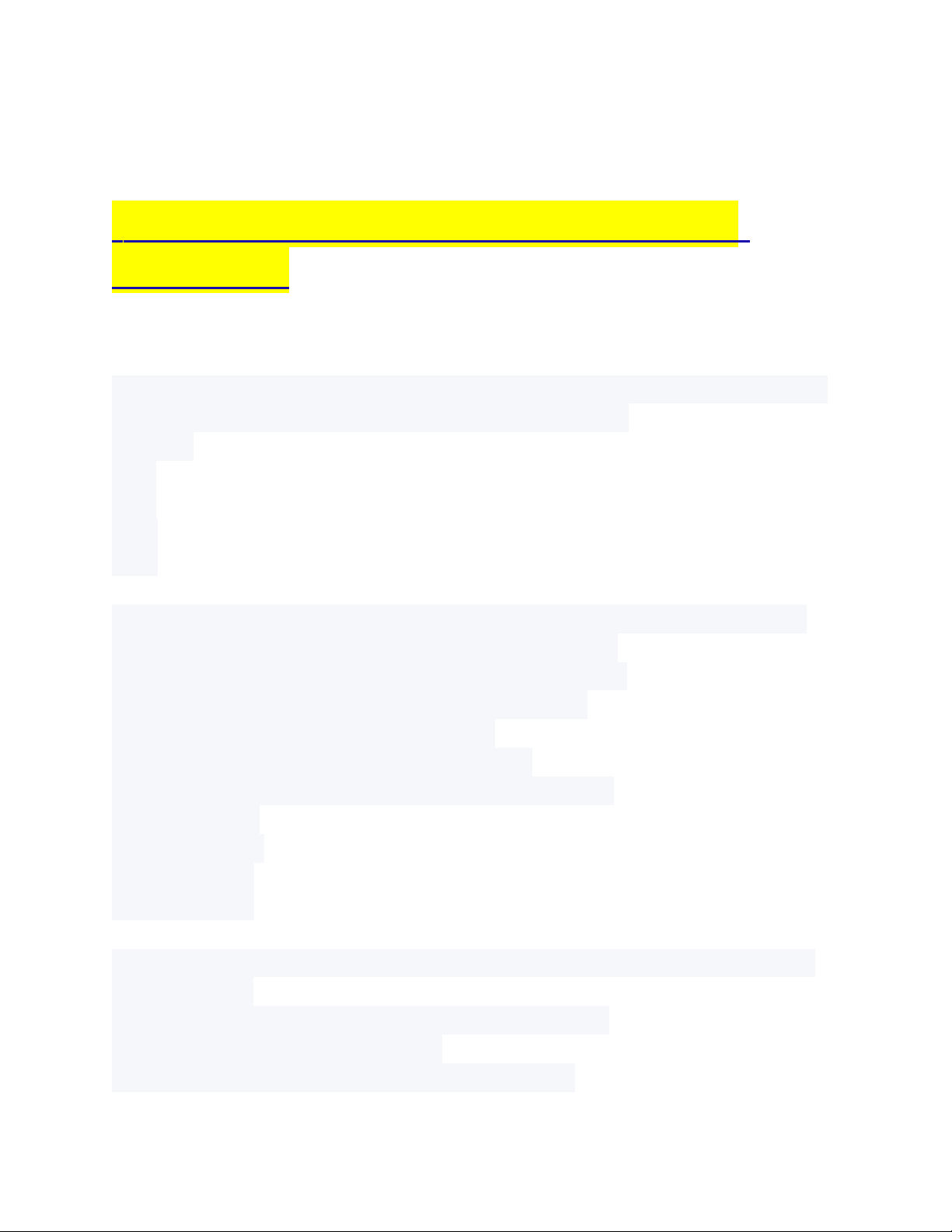

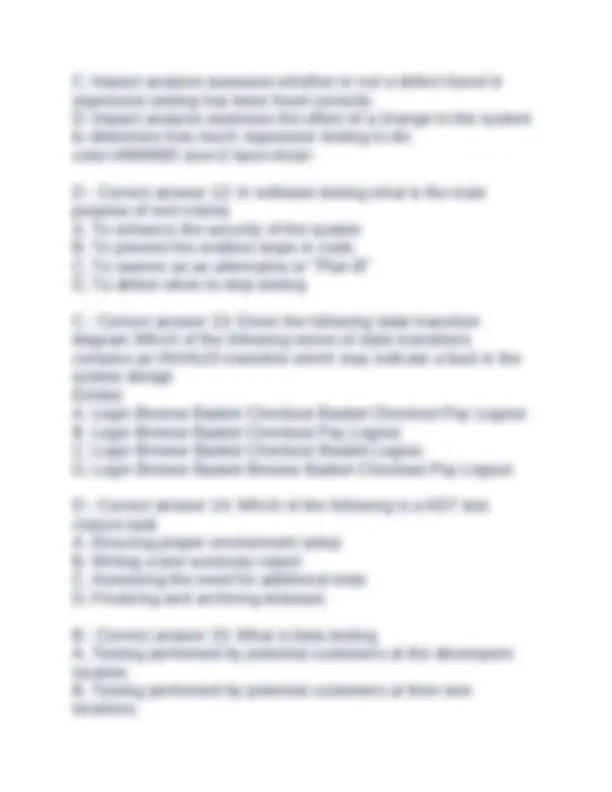
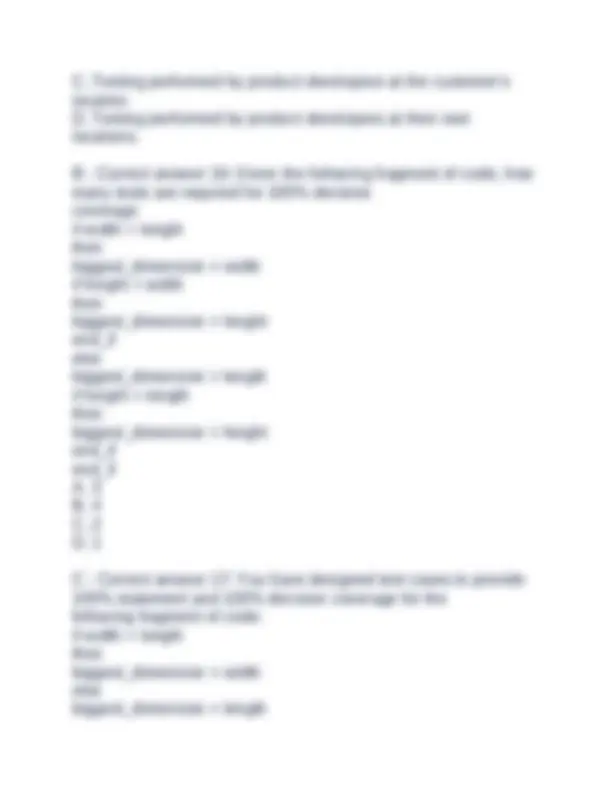
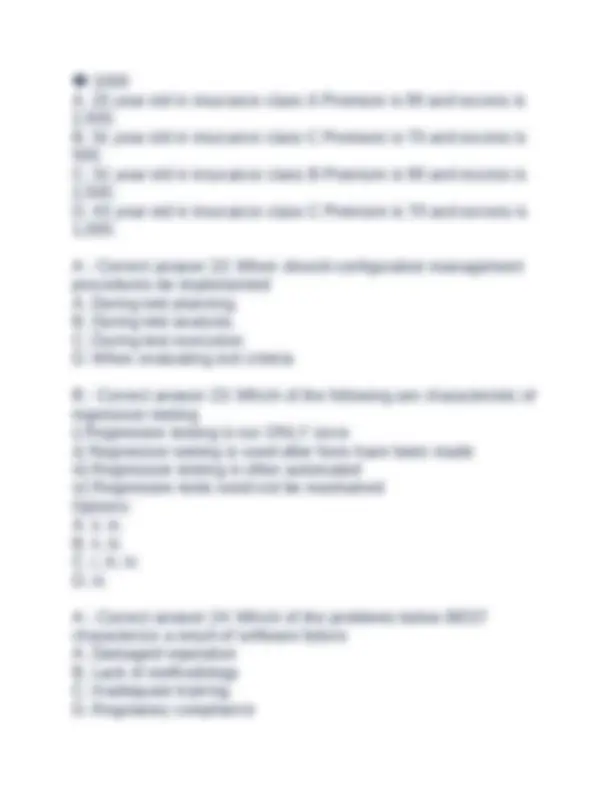
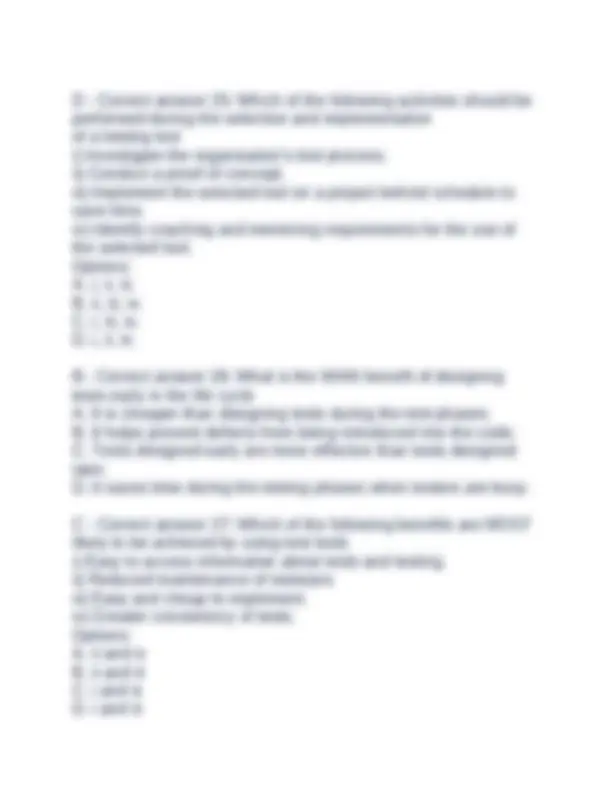
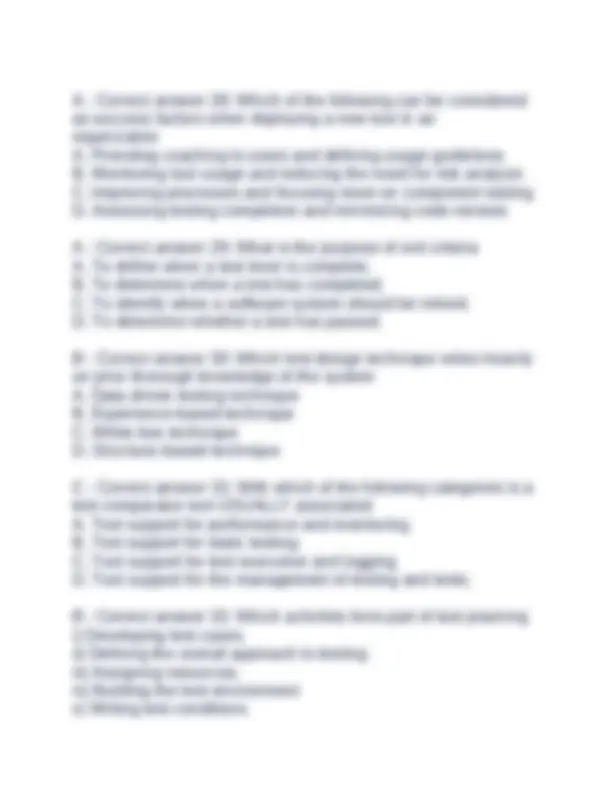
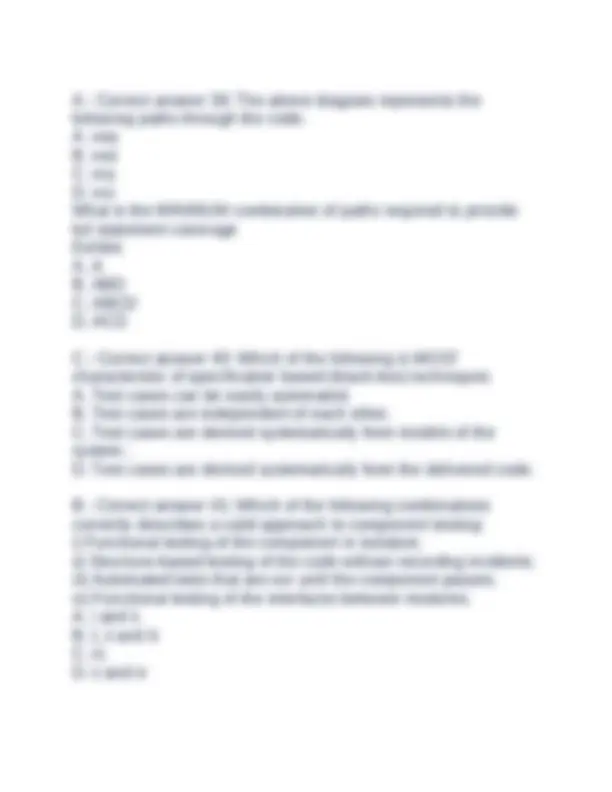
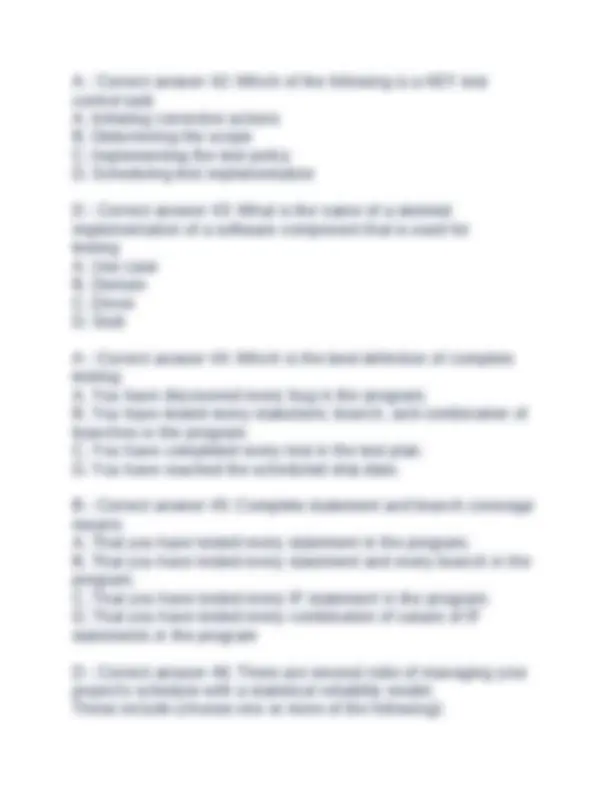

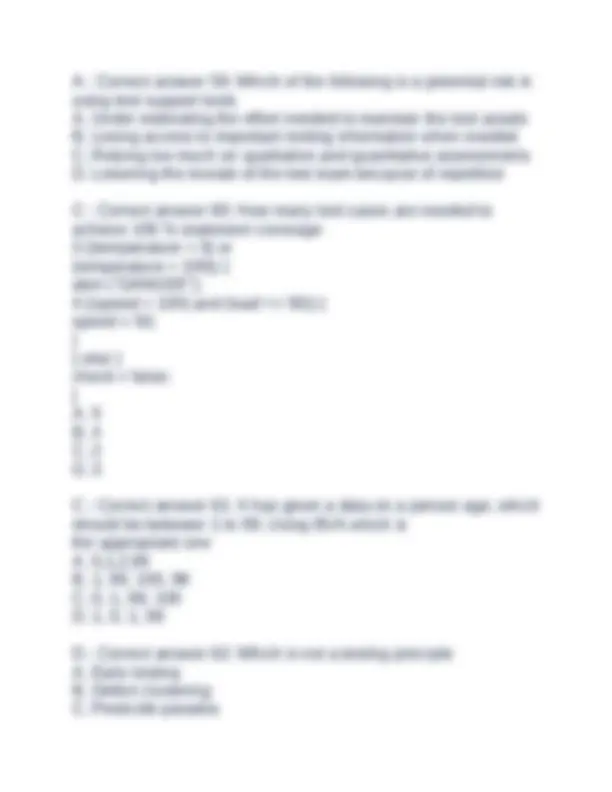
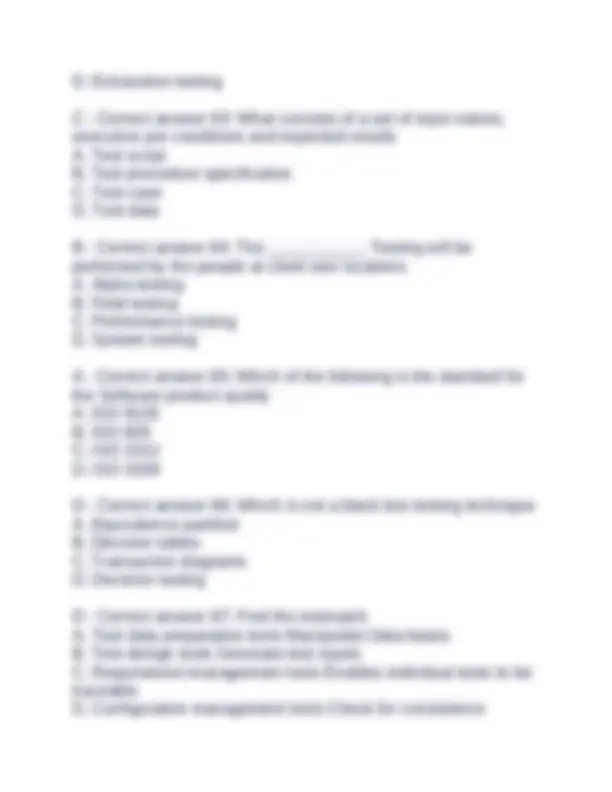


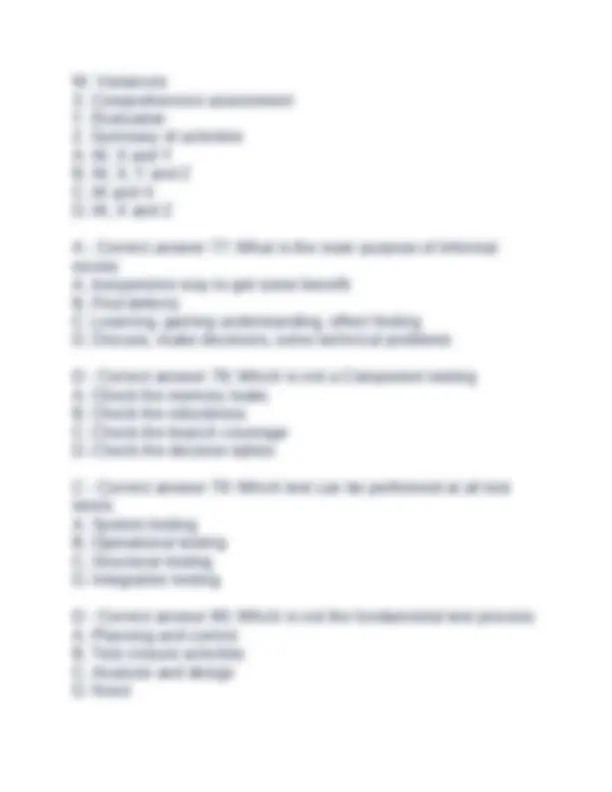
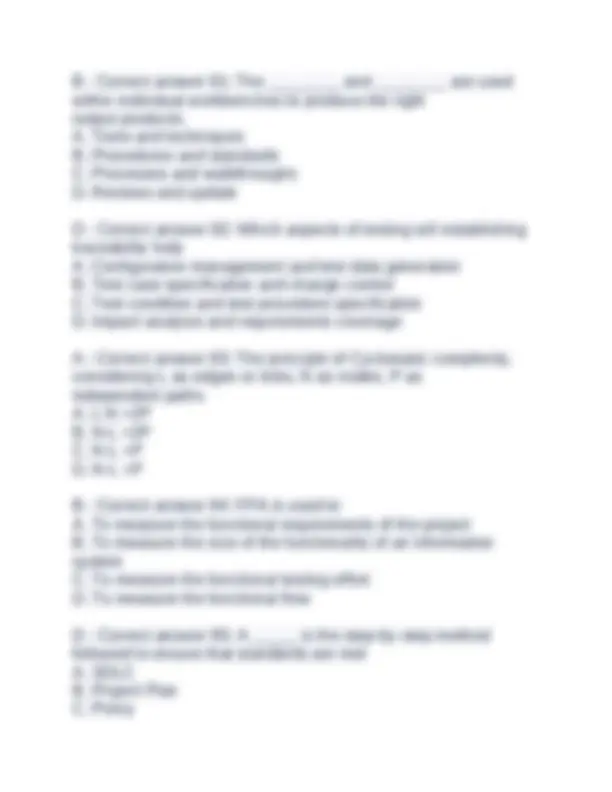


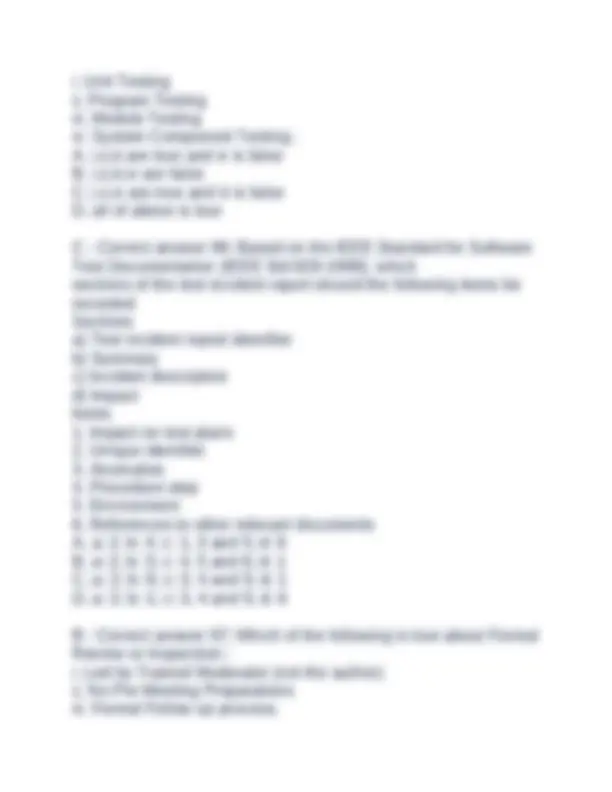
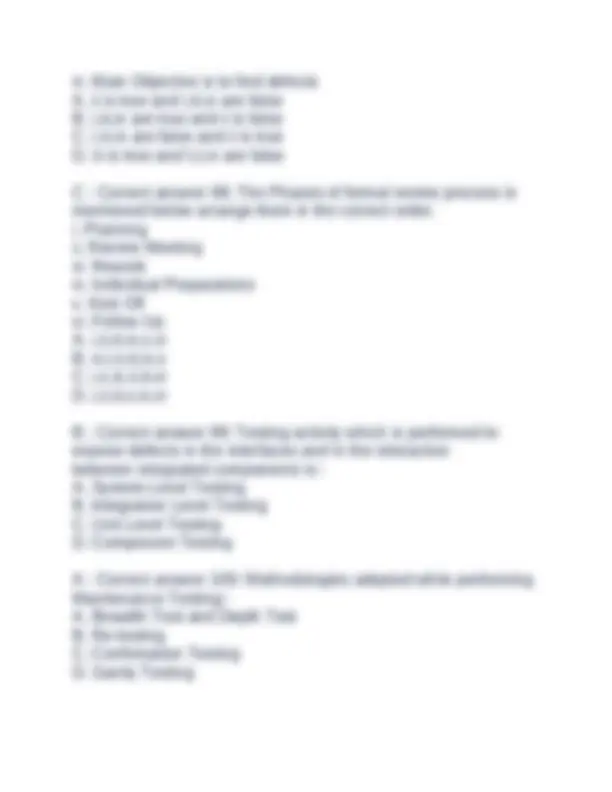

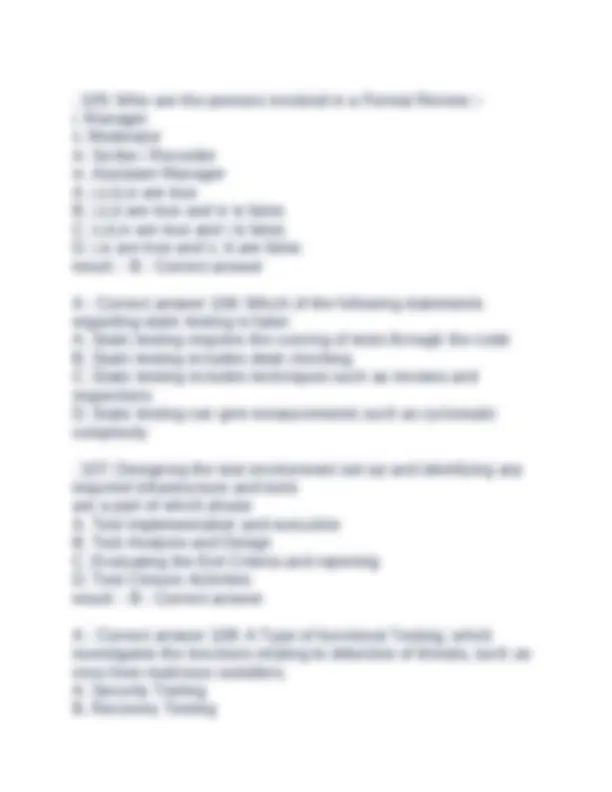
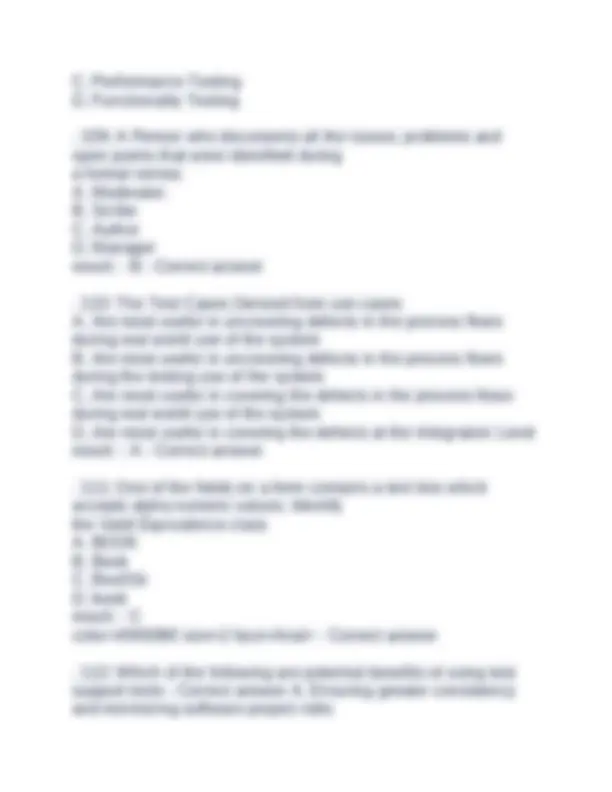
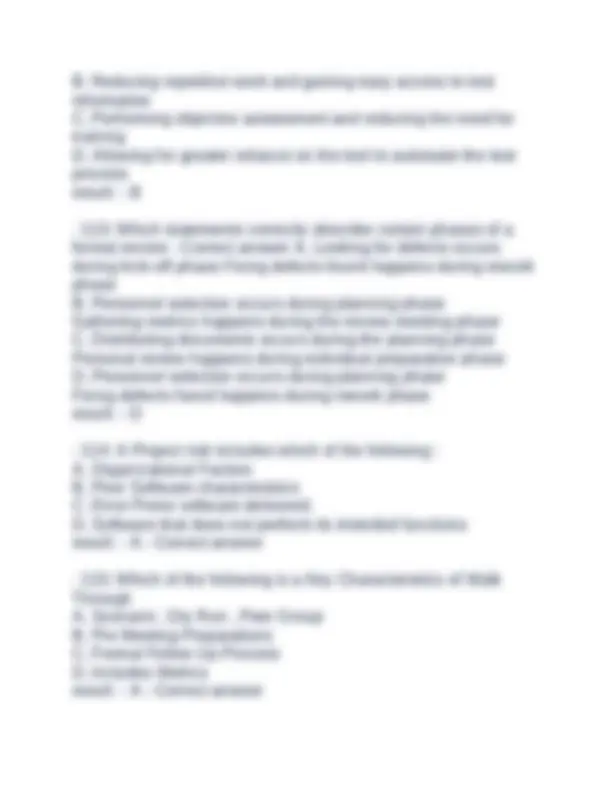
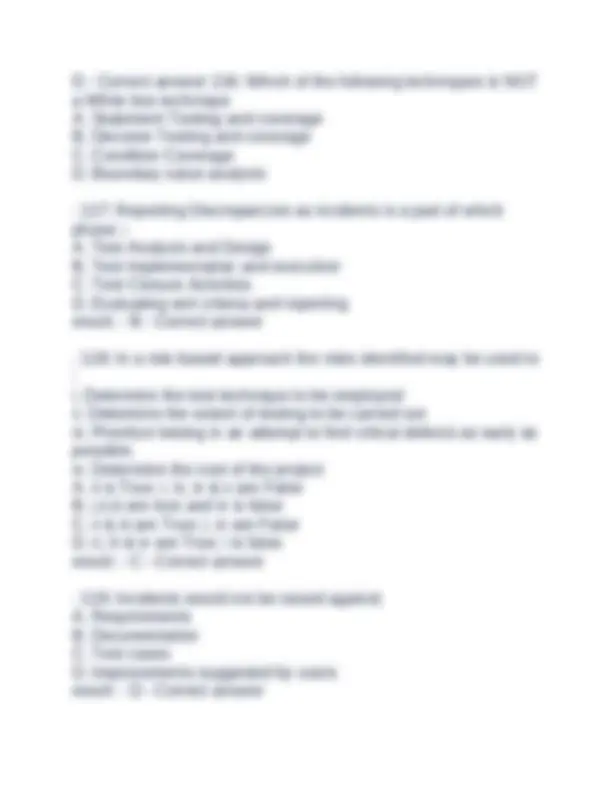
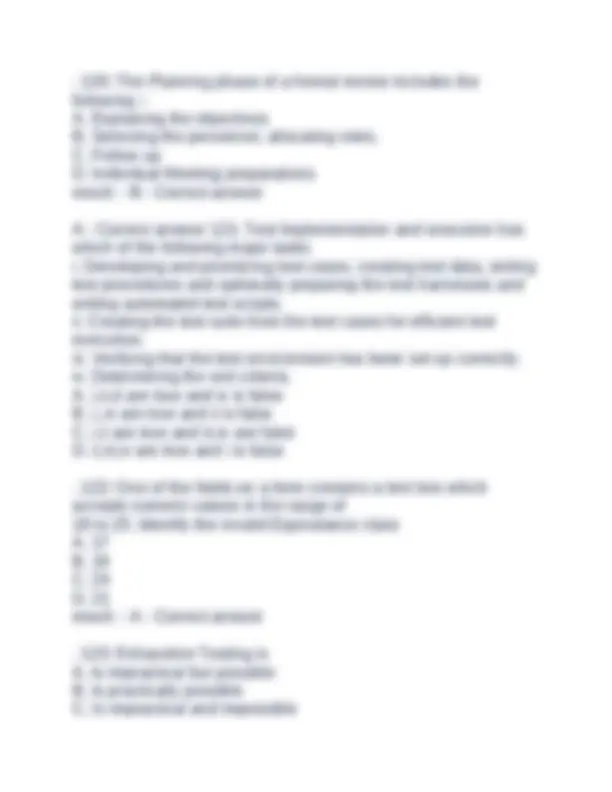
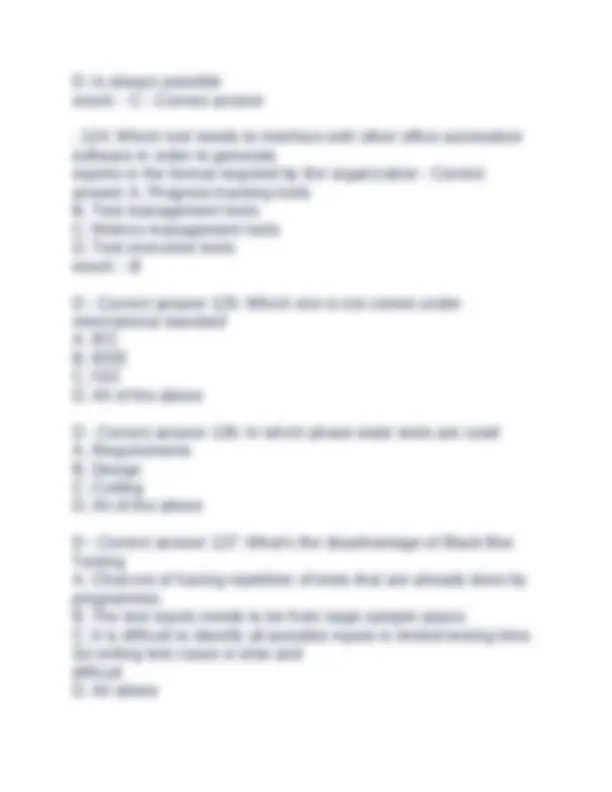

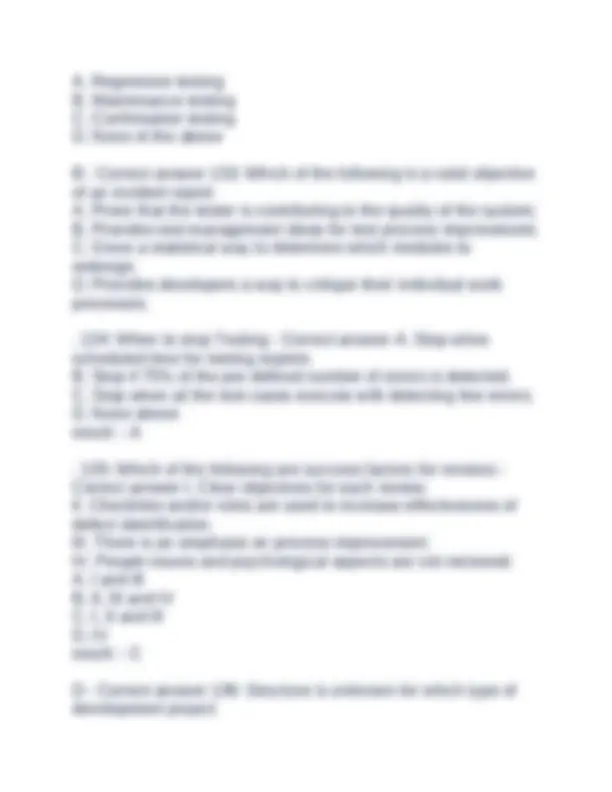
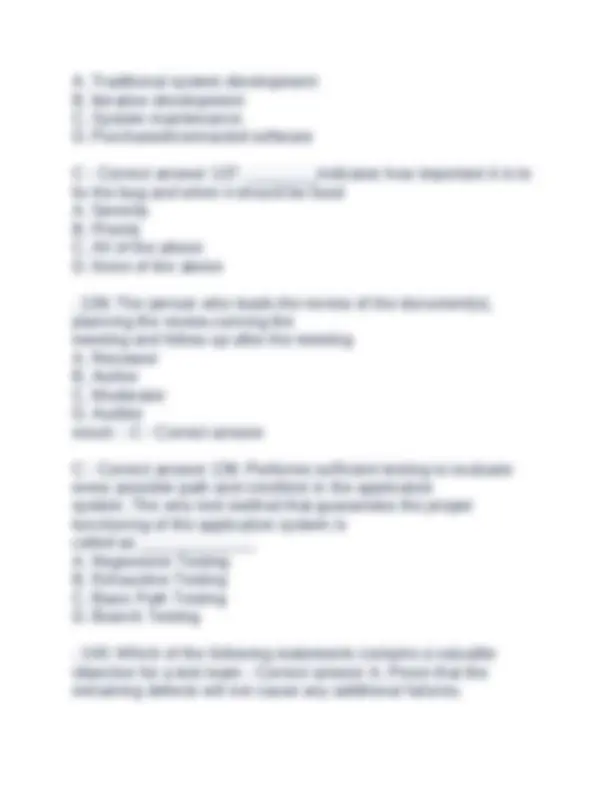
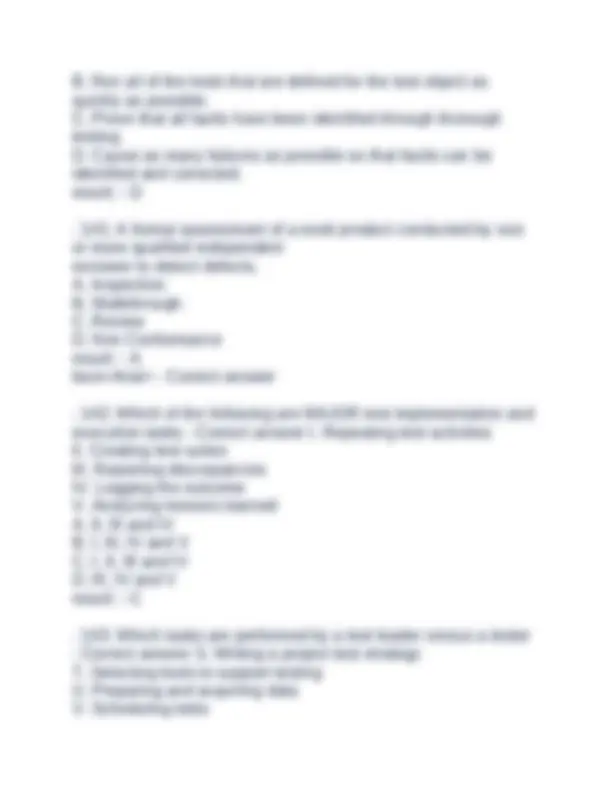
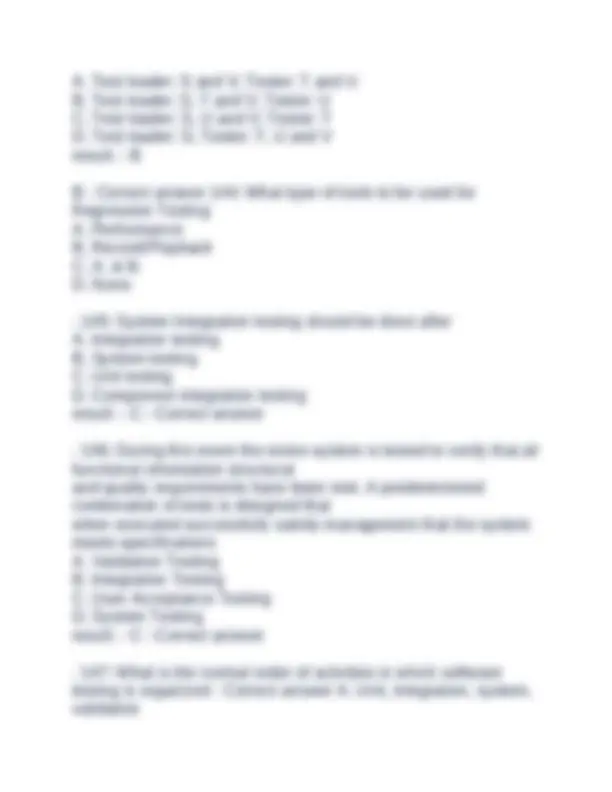
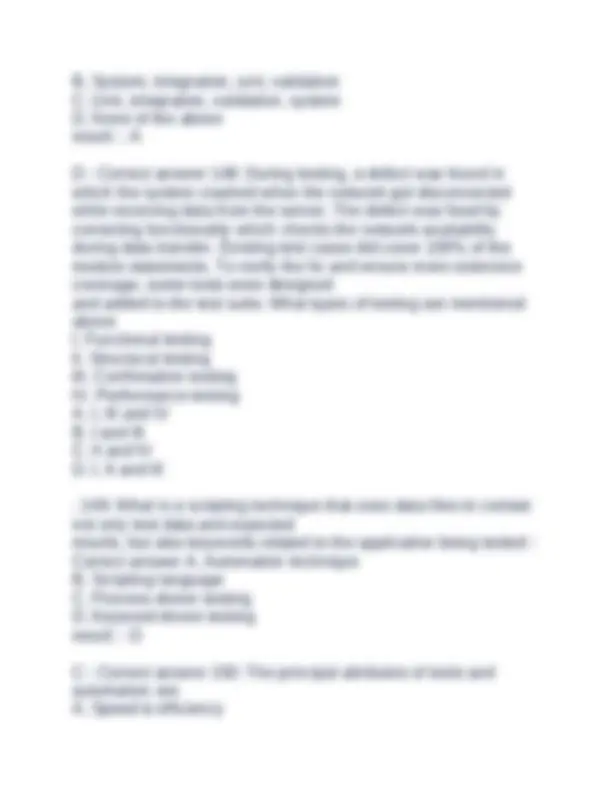
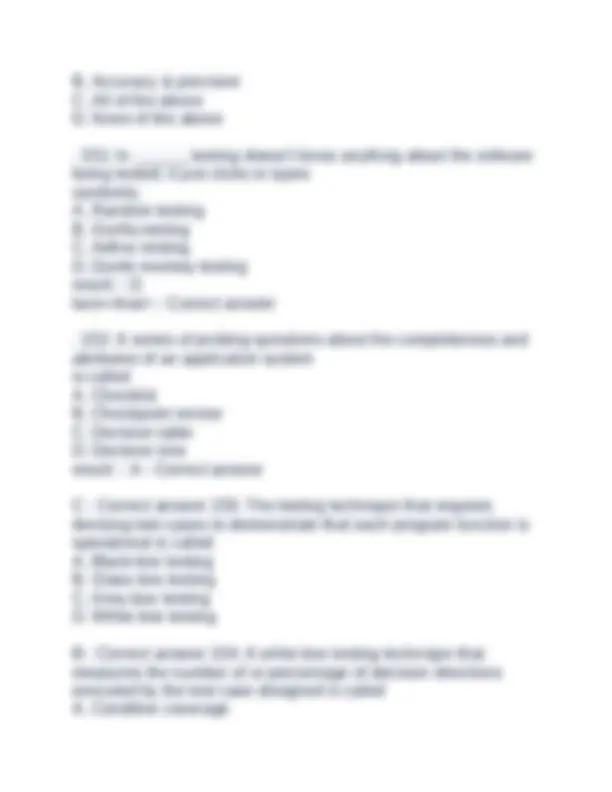
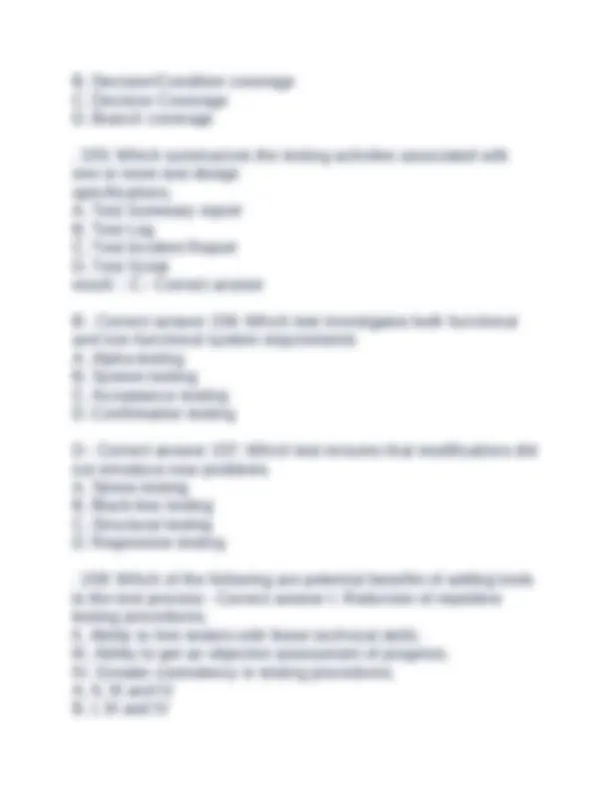
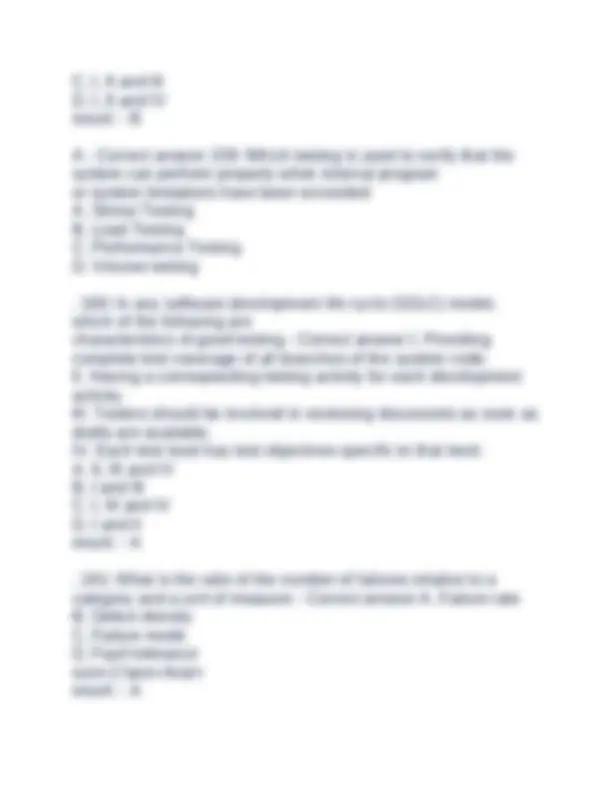
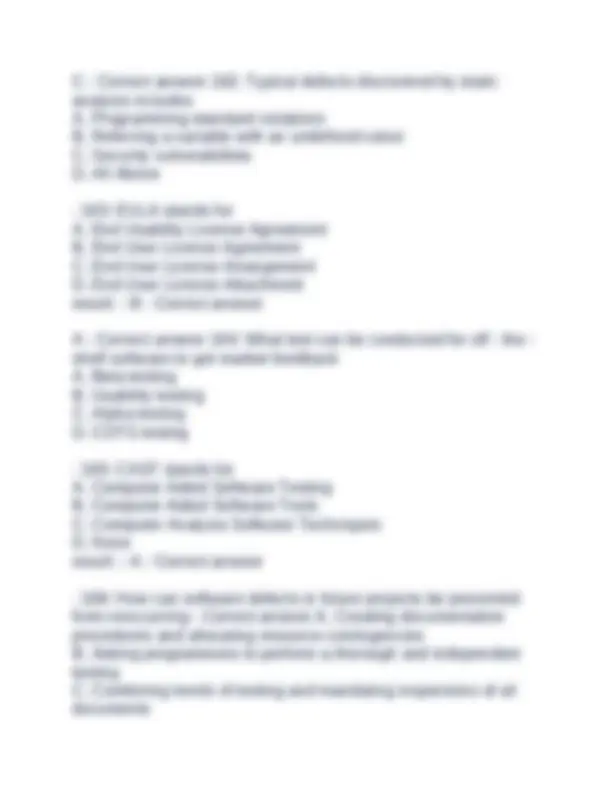
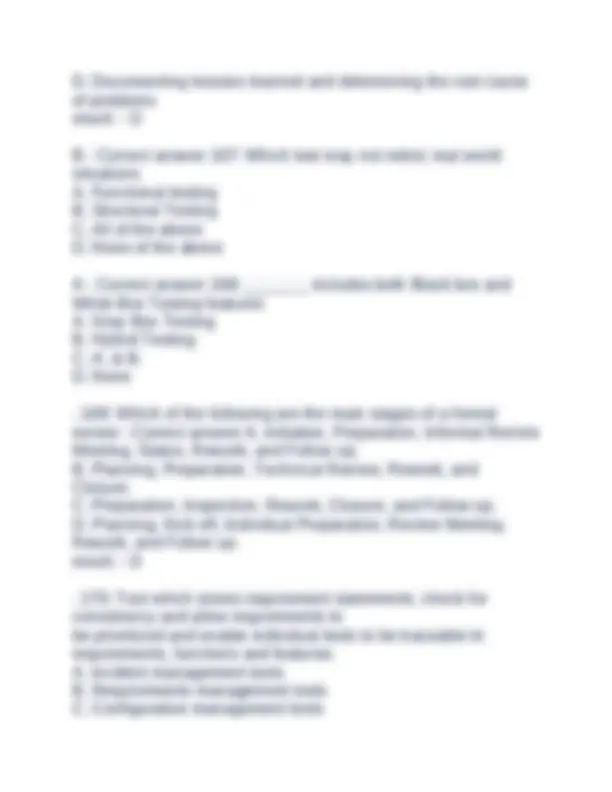
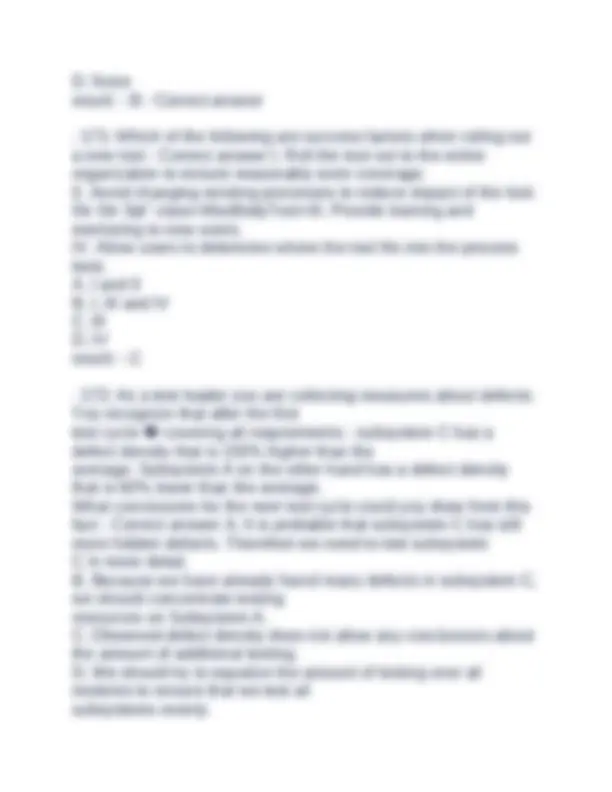
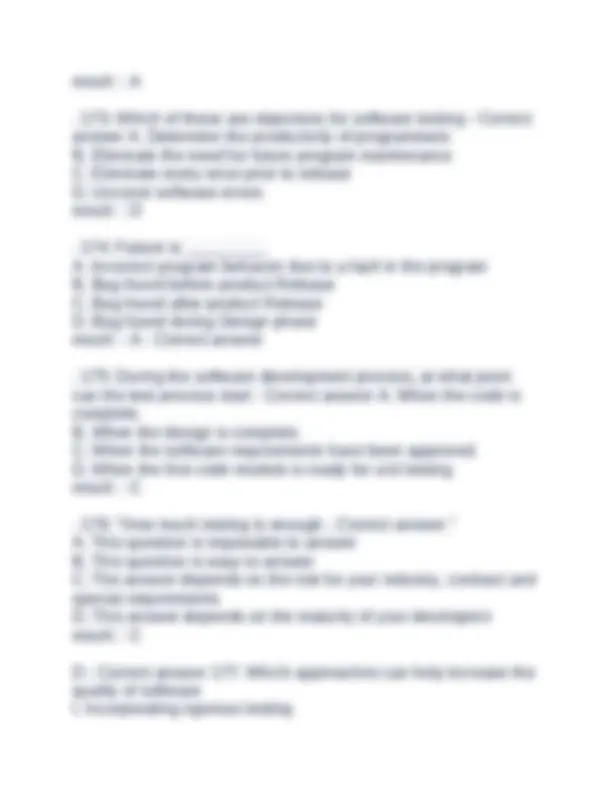
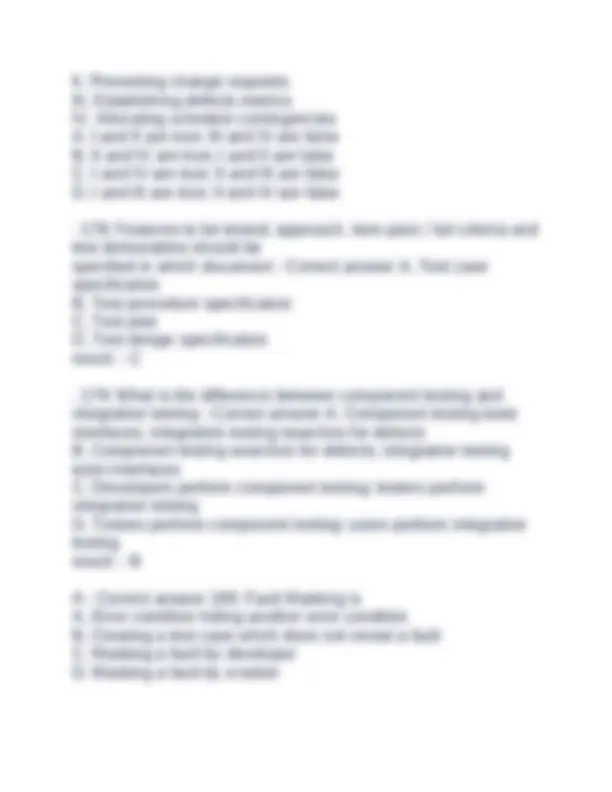

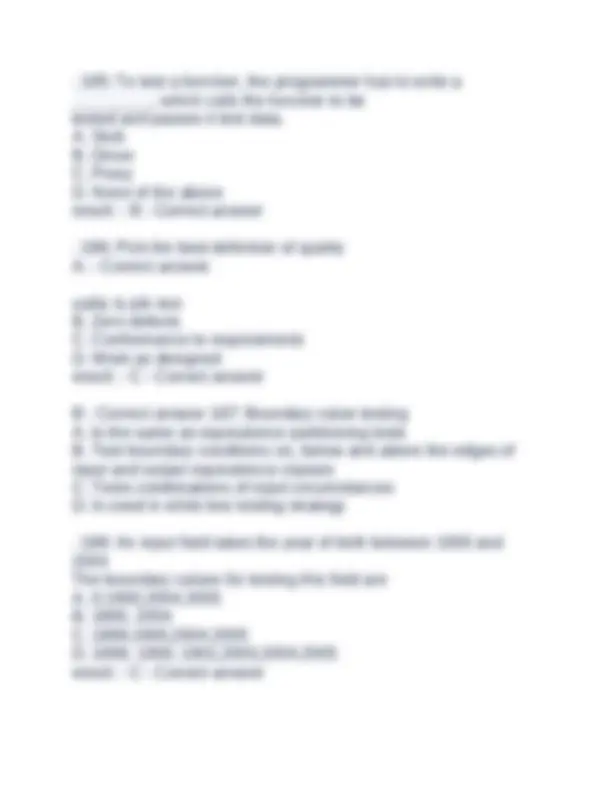
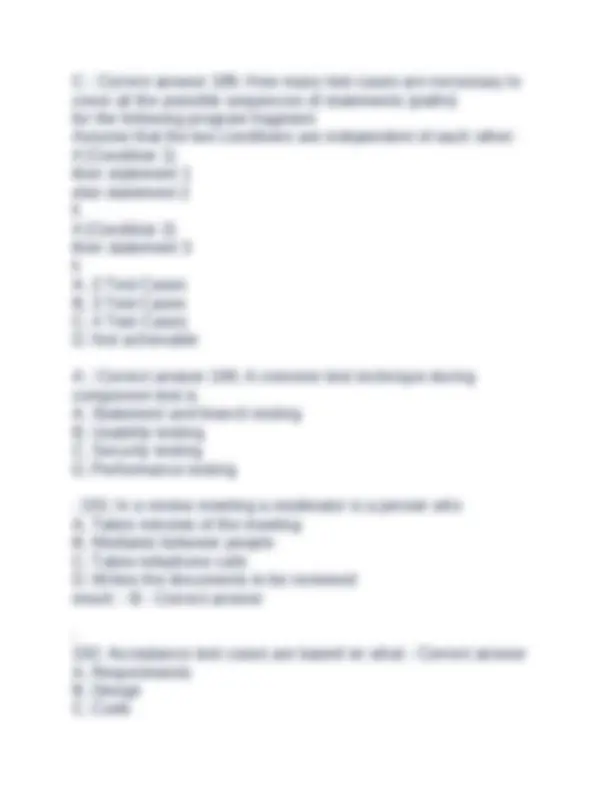
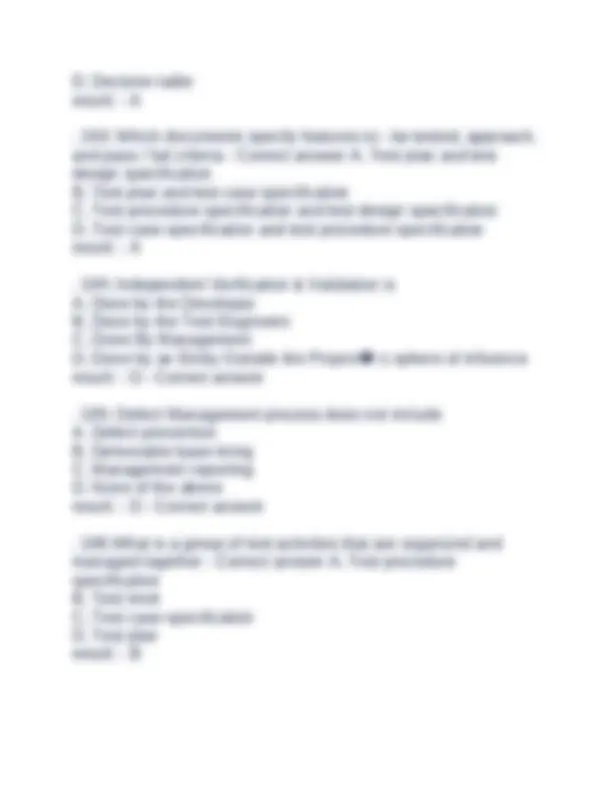
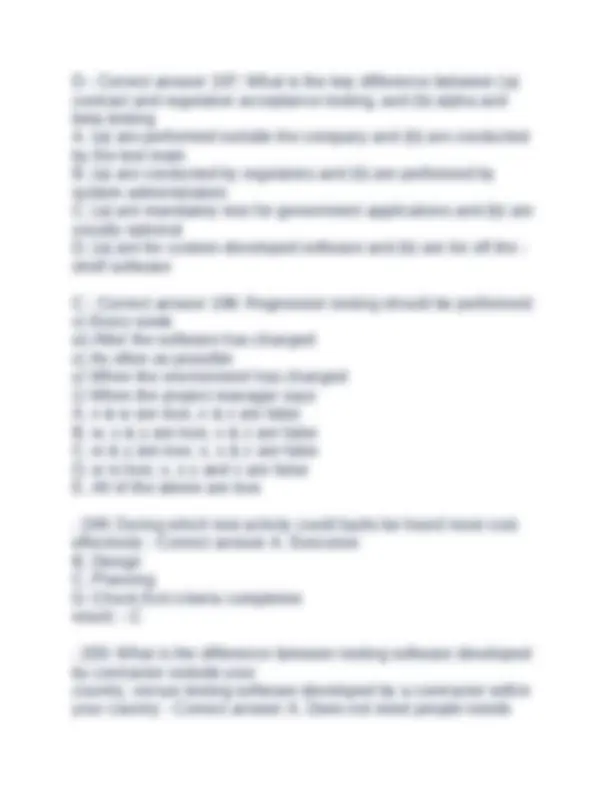
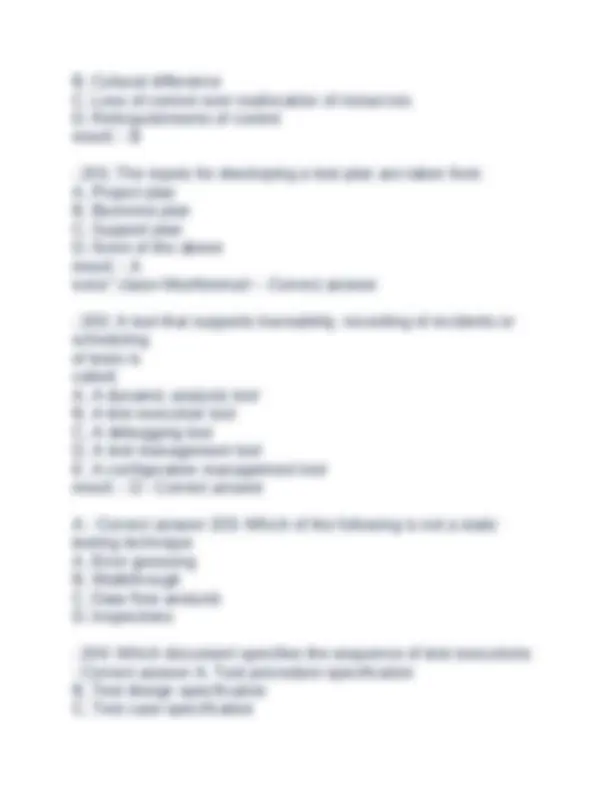

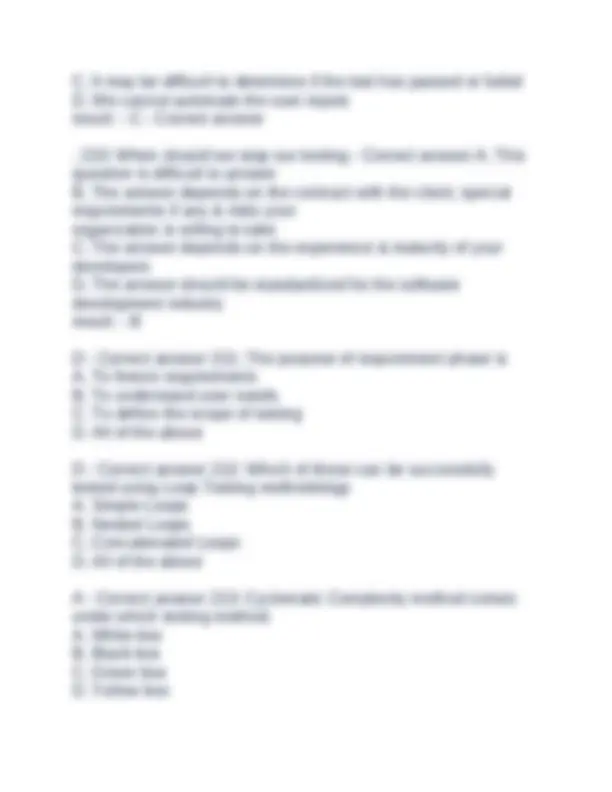
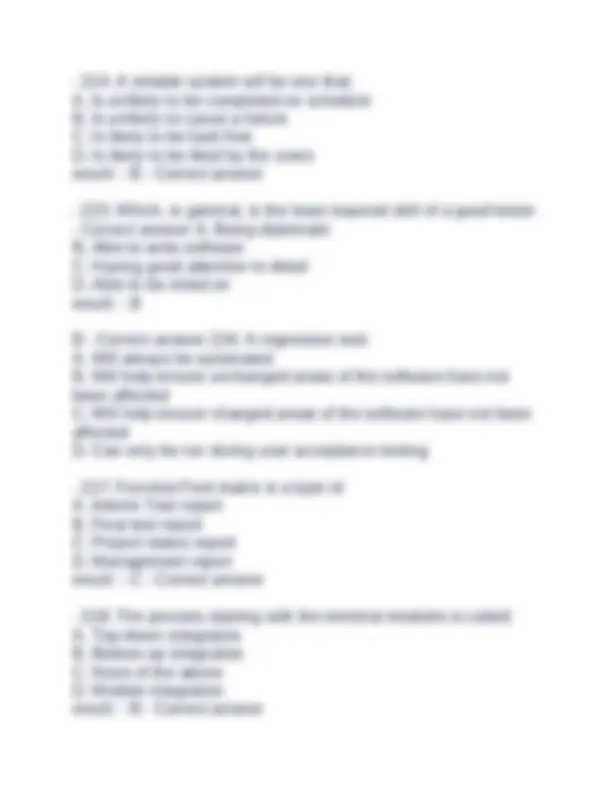

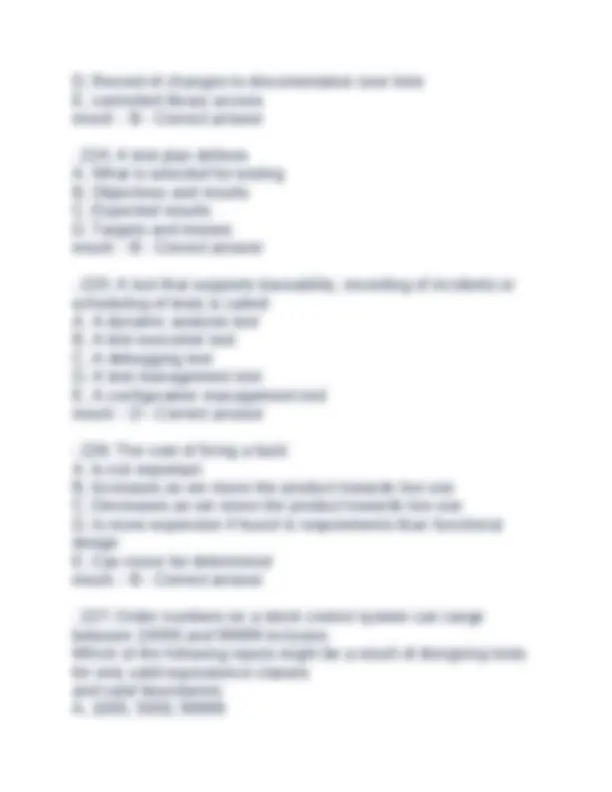
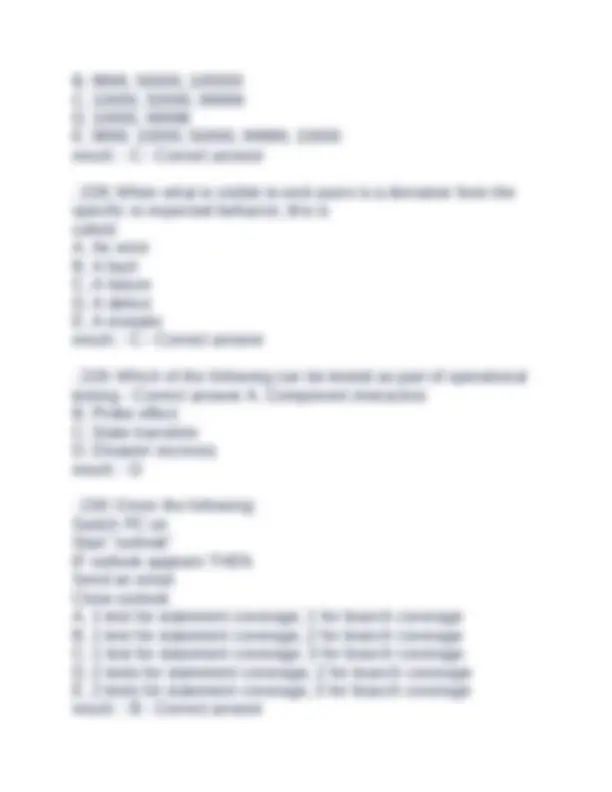

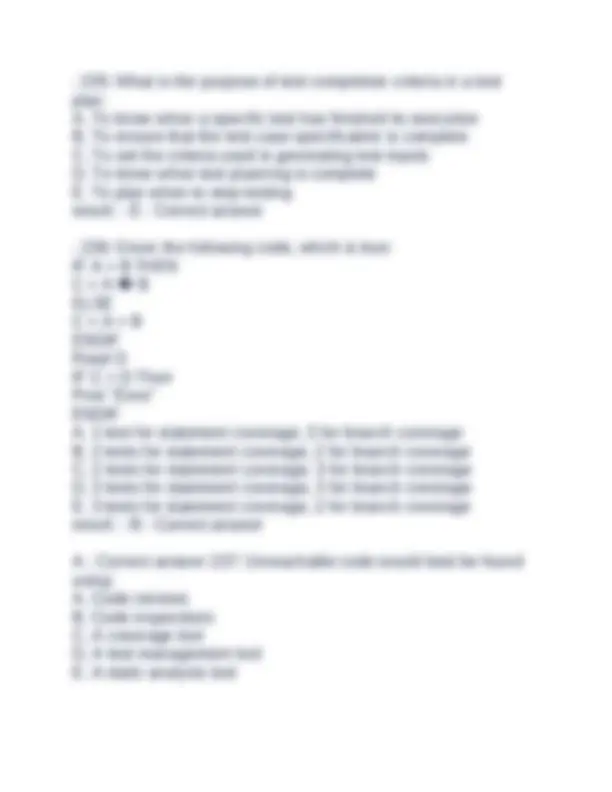
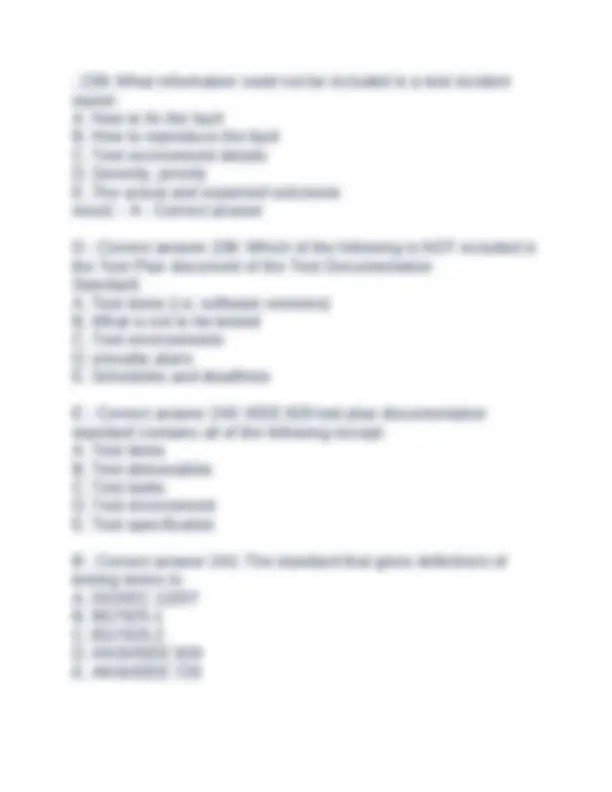

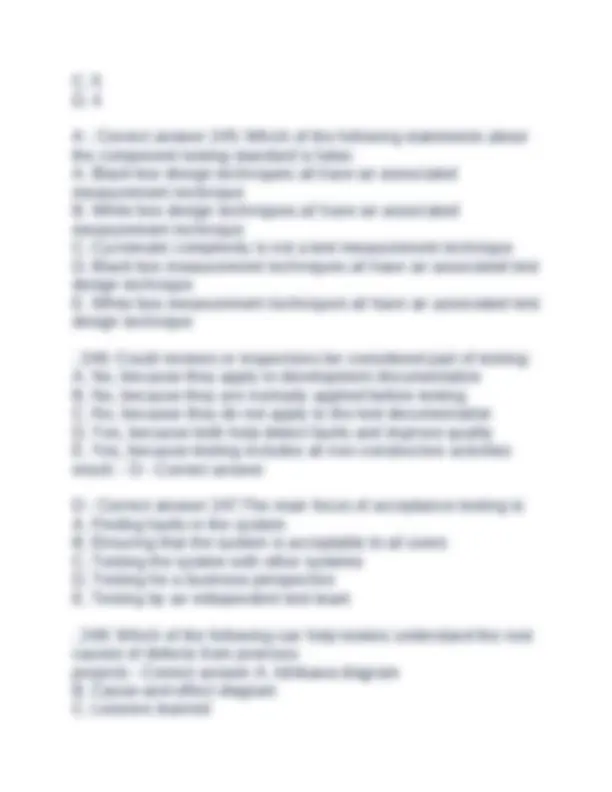
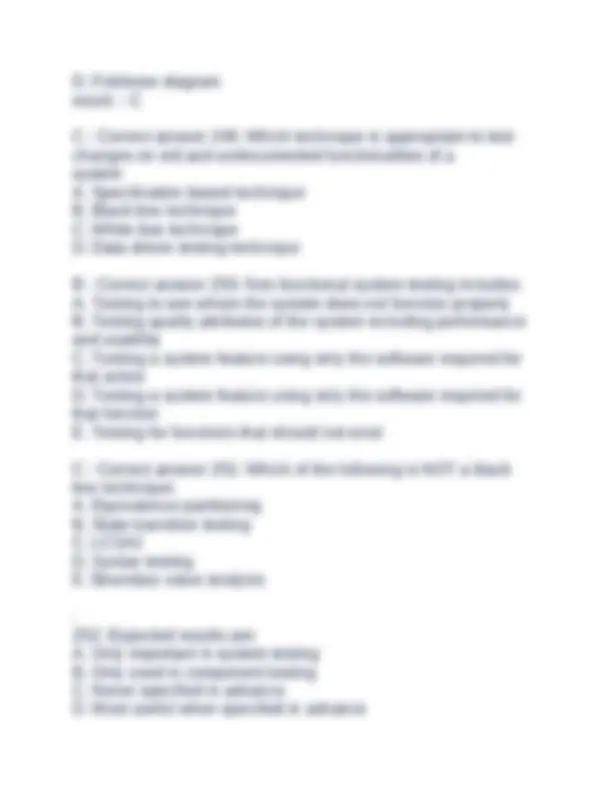
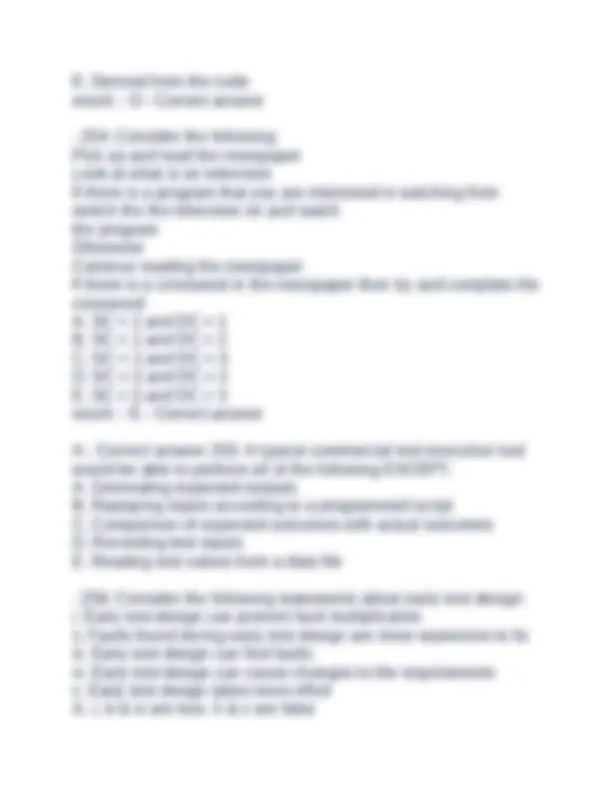
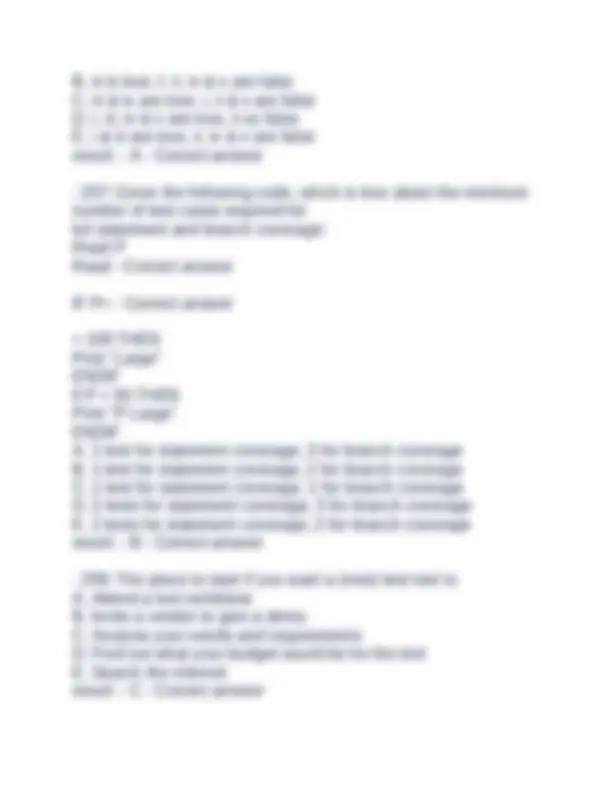

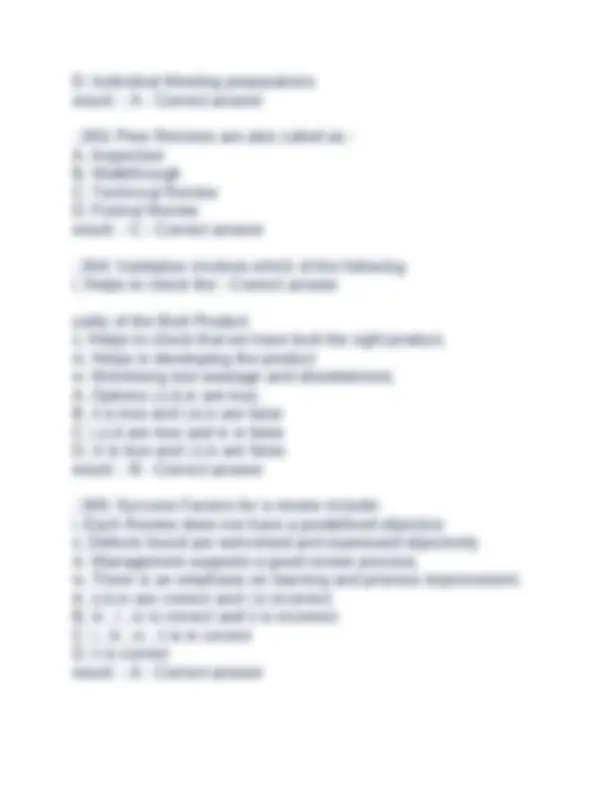
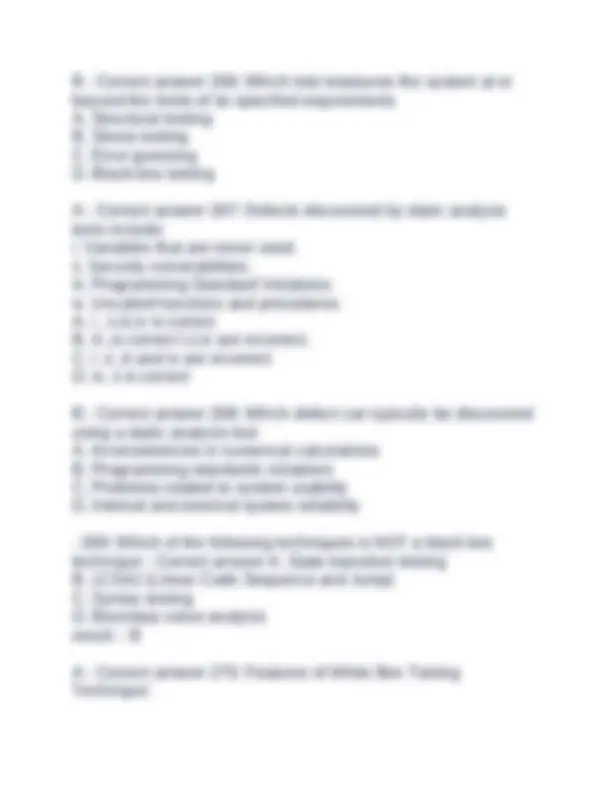
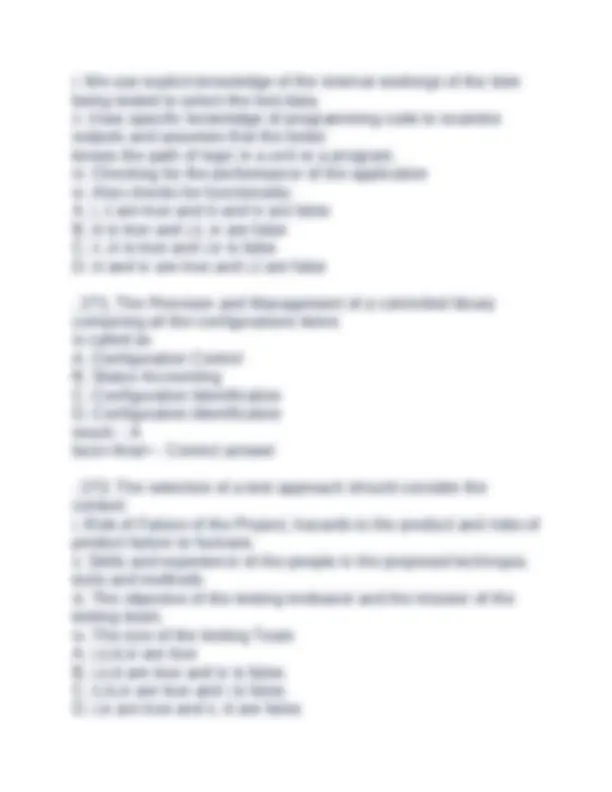

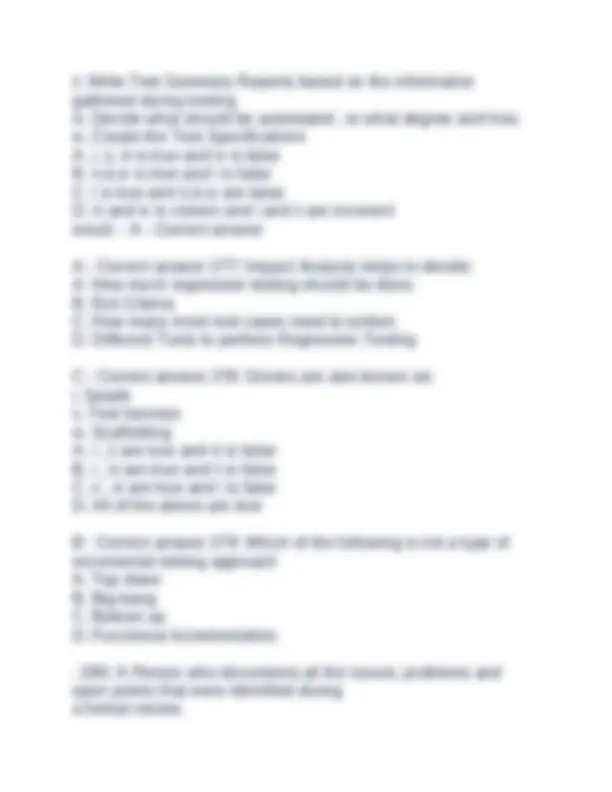

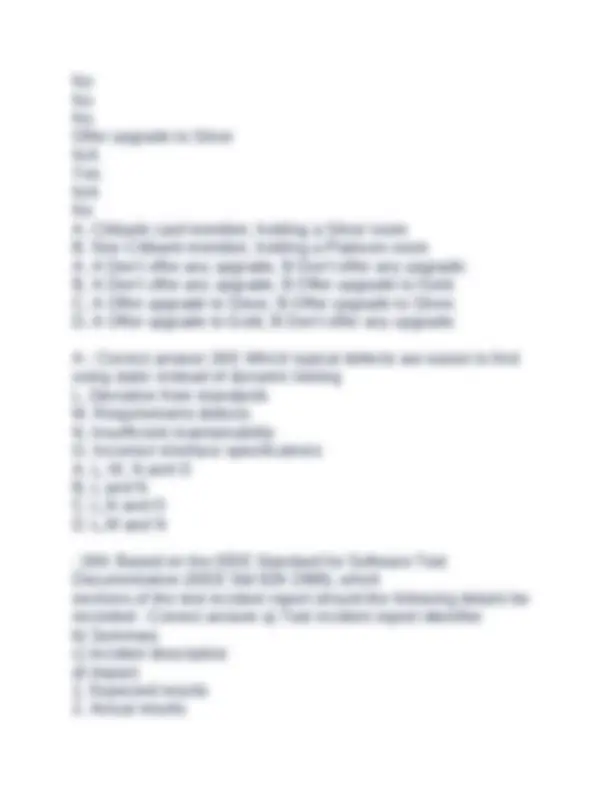
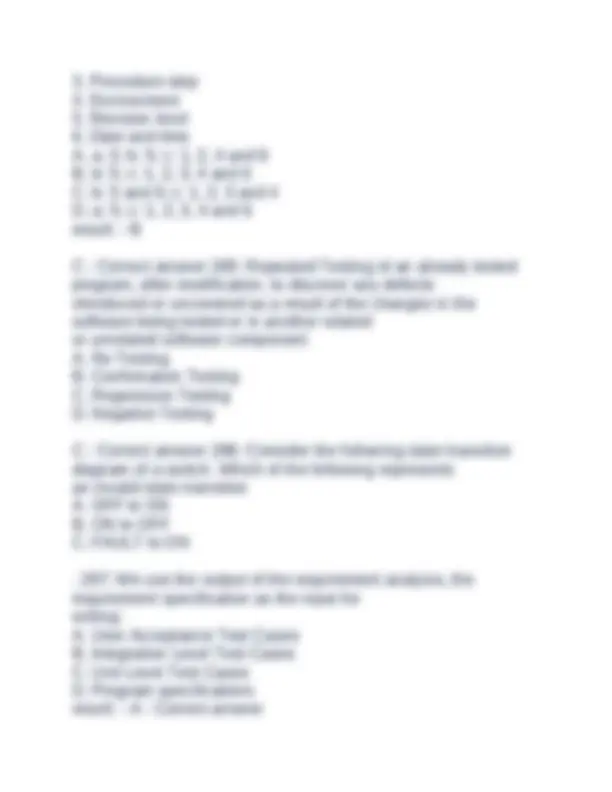
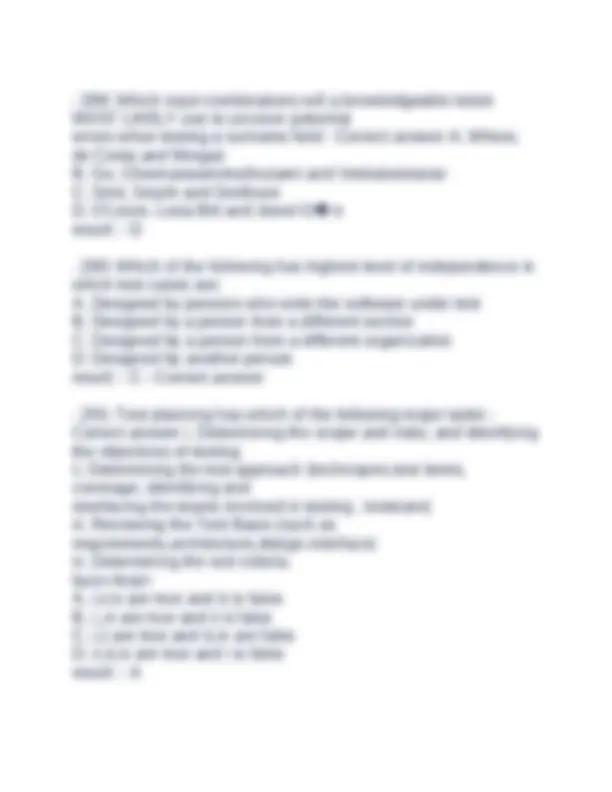
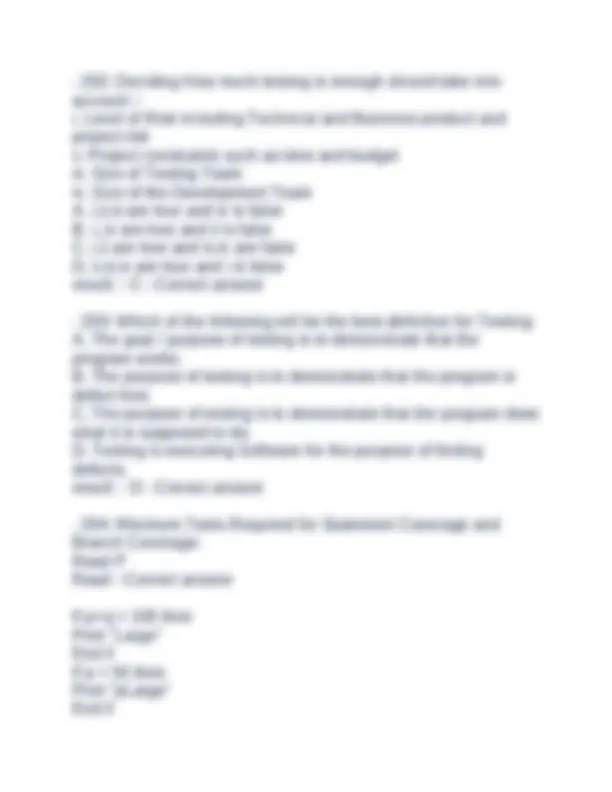
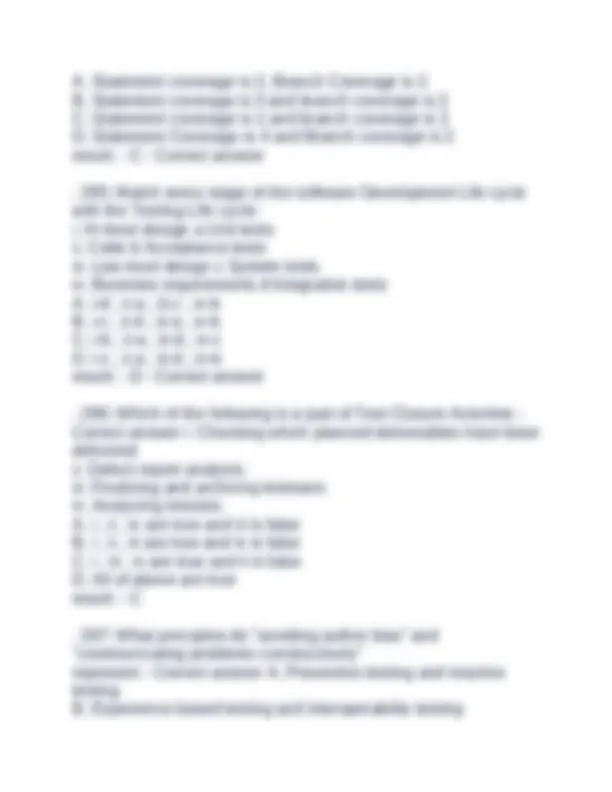


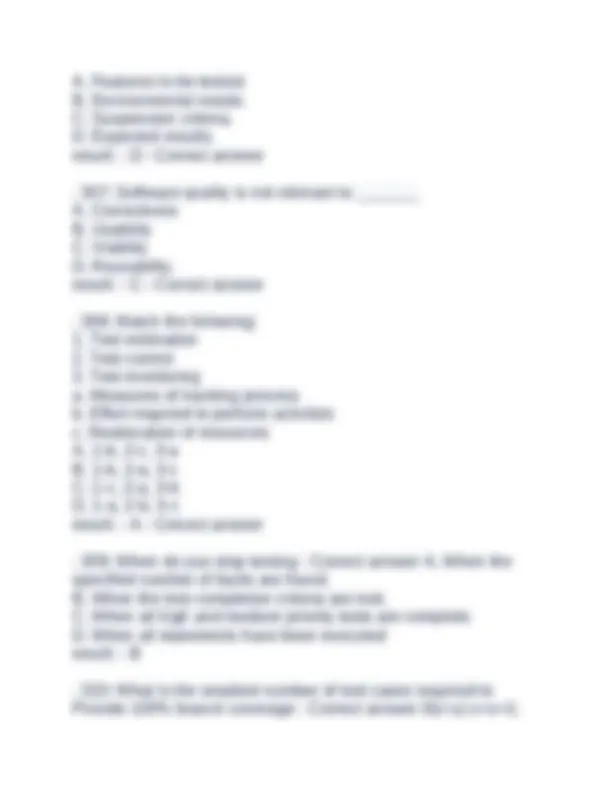
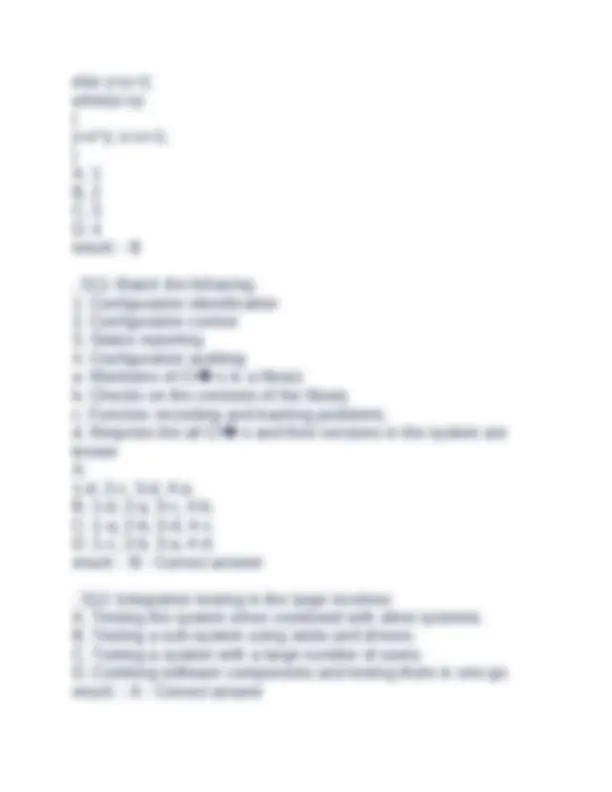
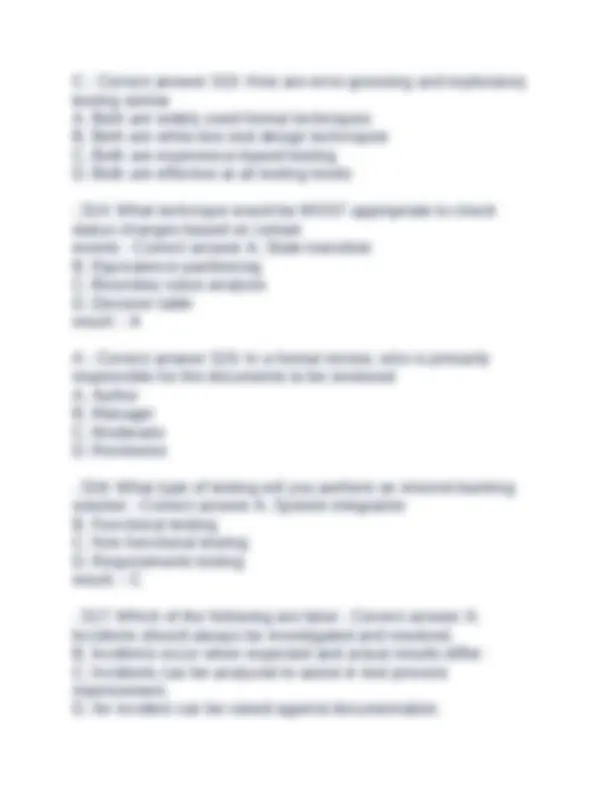
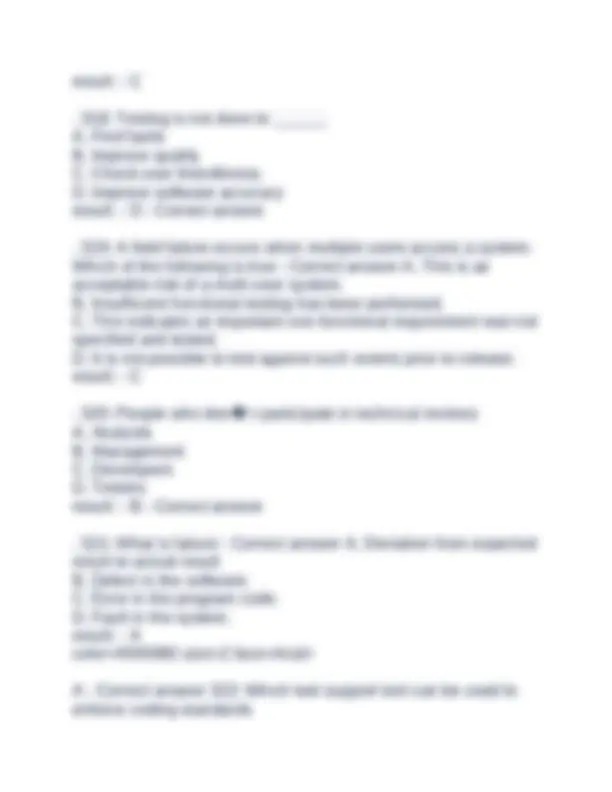
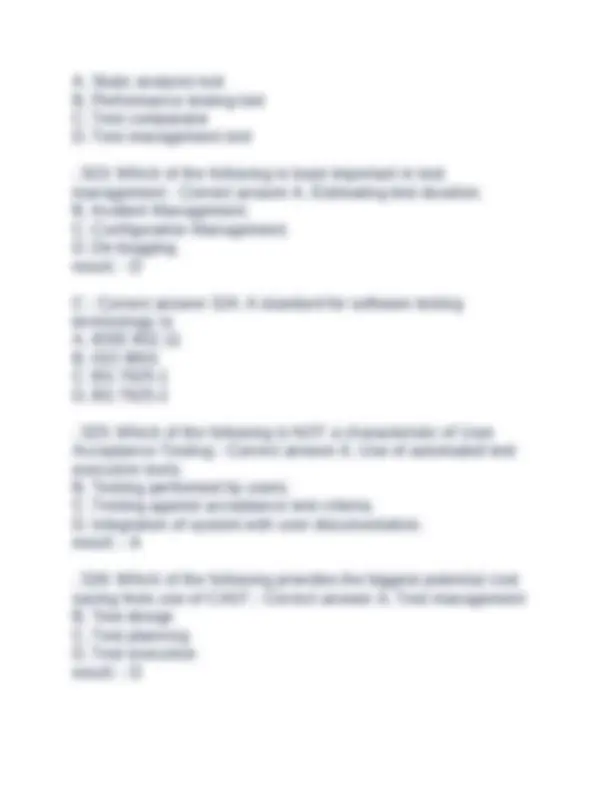

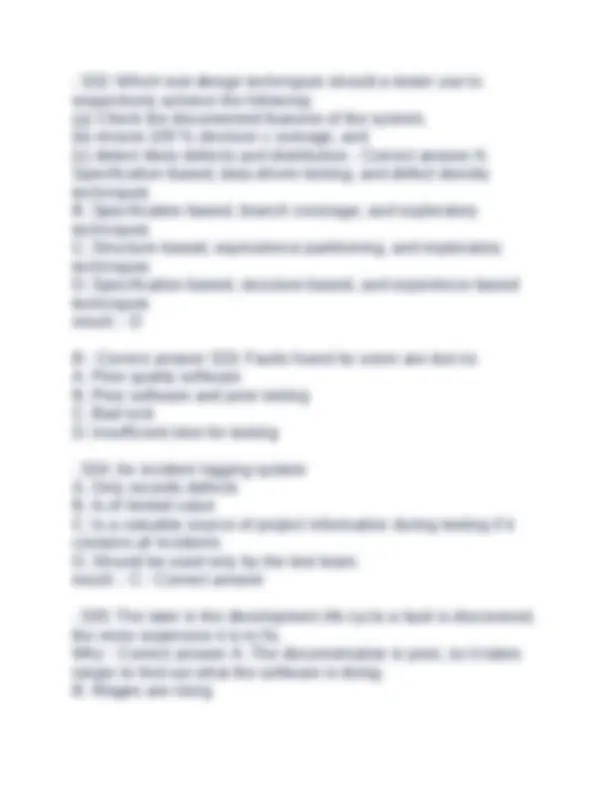
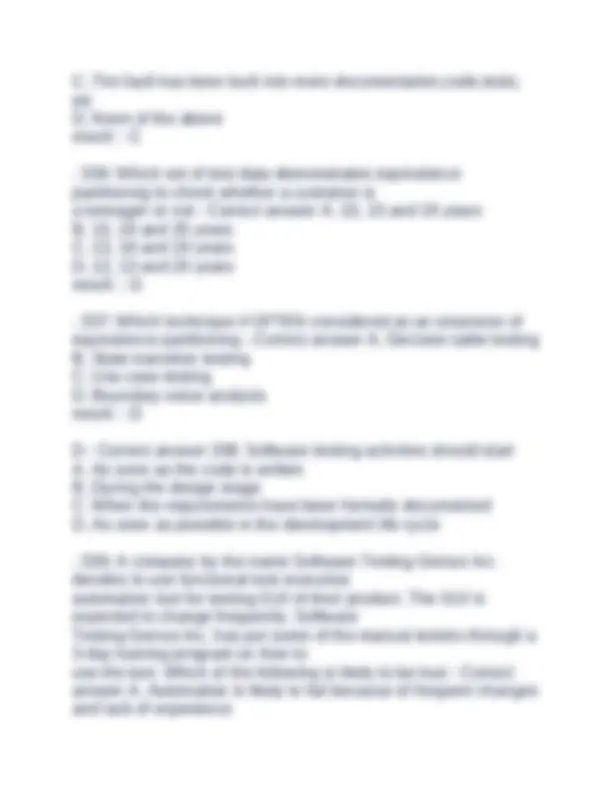
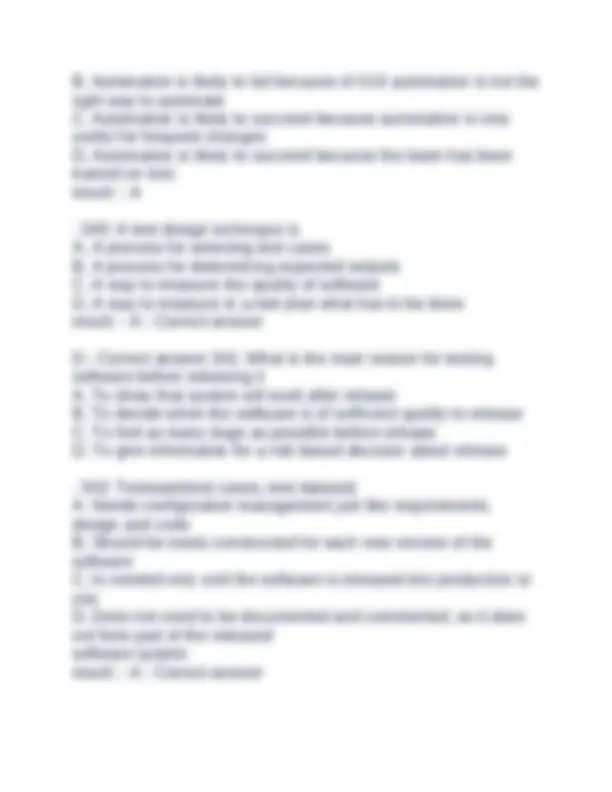
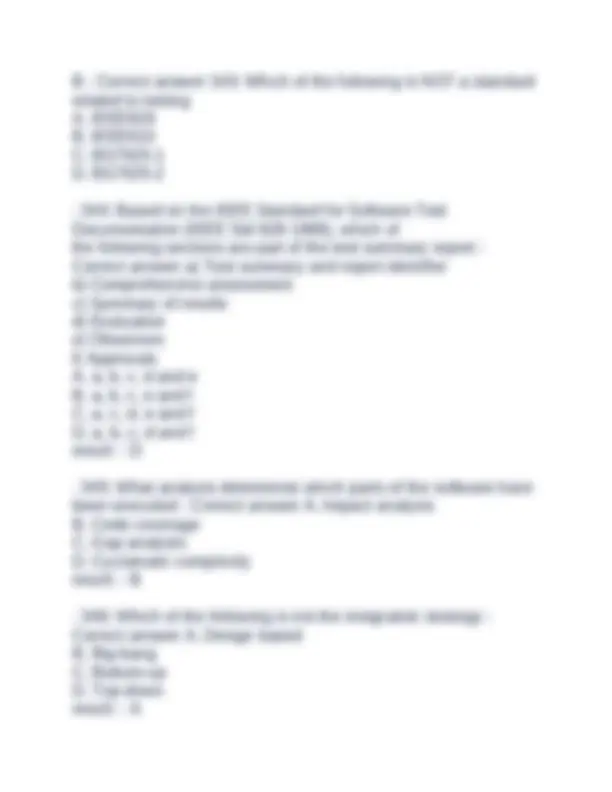
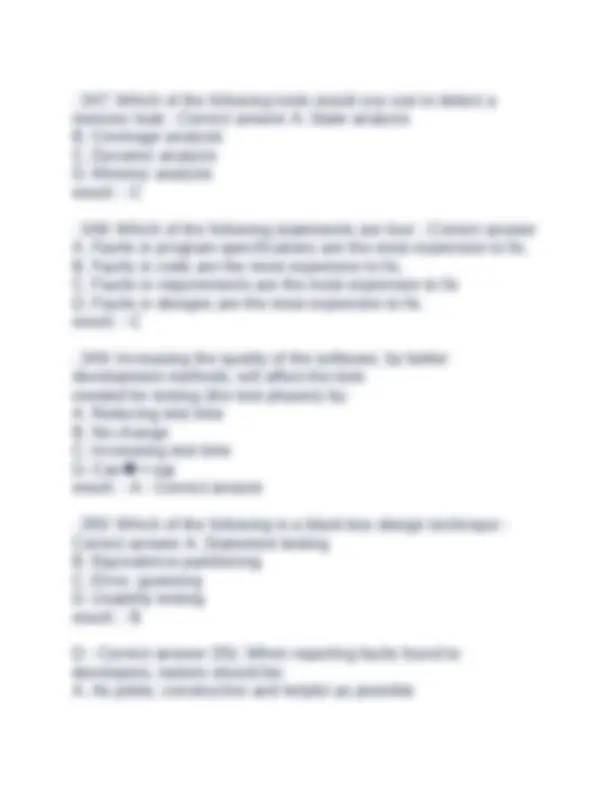


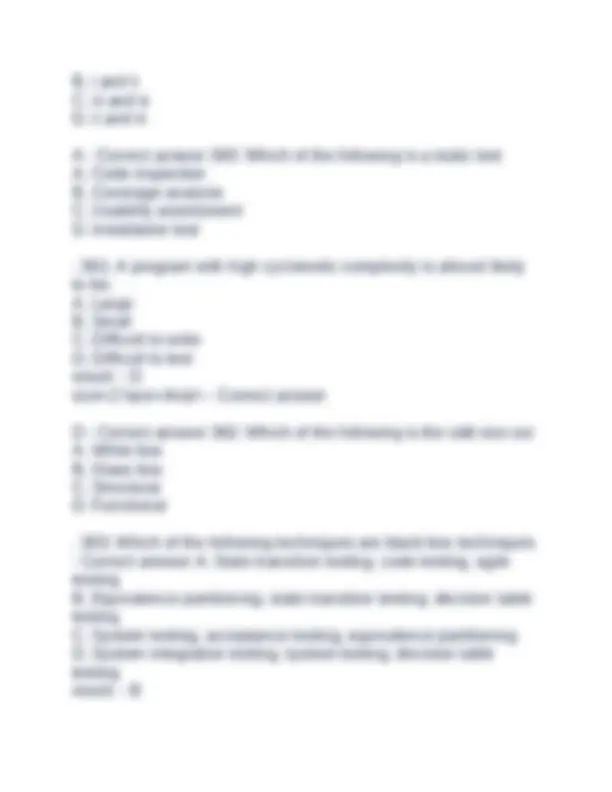
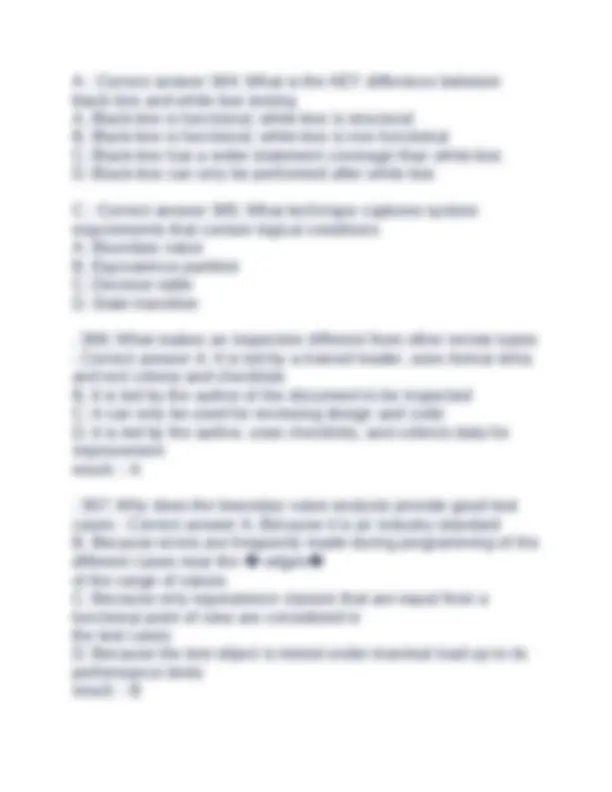
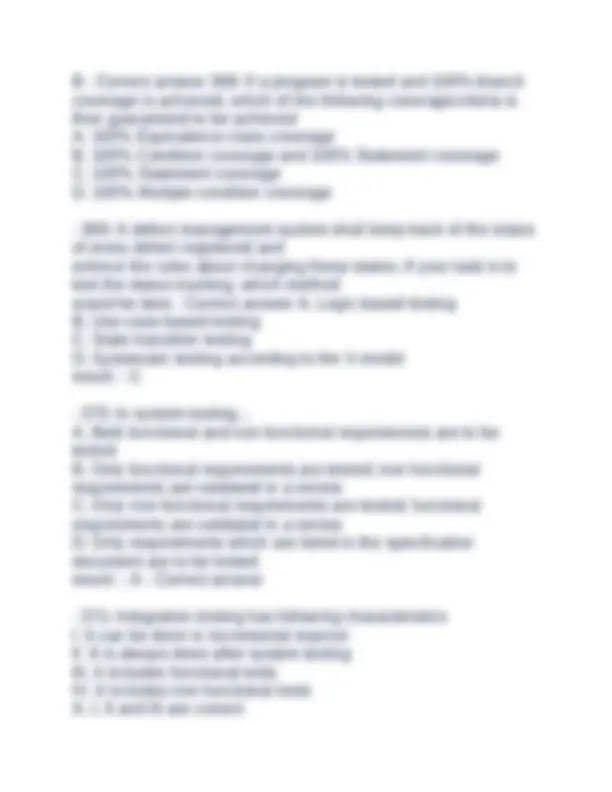

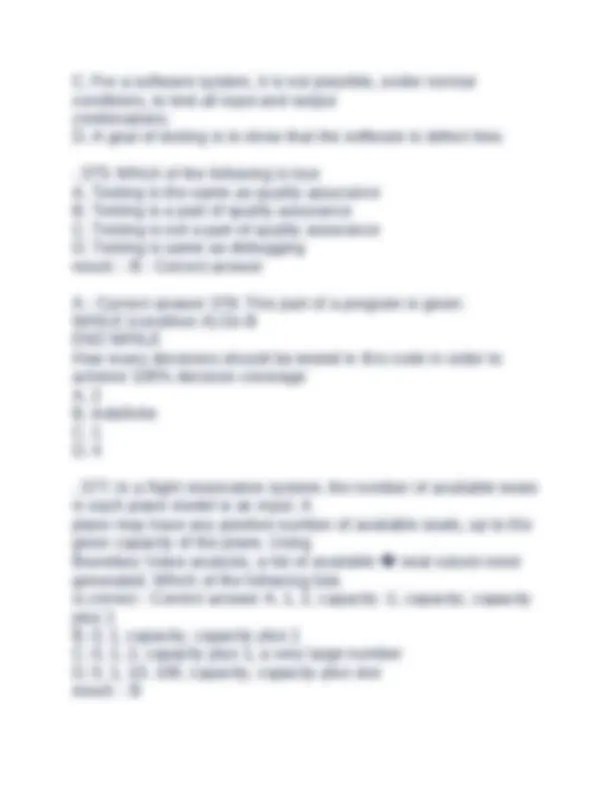


Study with the several resources on Docsity

Earn points by helping other students or get them with a premium plan


Prepare for your exams
Study with the several resources on Docsity

Earn points to download
Earn points by helping other students or get them with a premium plan
Community
Ask the community for help and clear up your study doubts
Discover the best universities in your country according to Docsity users
Free resources
Download our free guides on studying techniques, anxiety management strategies, and thesis advice from Docsity tutors
A series of multiple-choice questions and answers related to software testing, including topics such as test planning, test design techniques, test execution, and test closure. The questions cover various aspects of software testing, including decision tables, configuration management, debugging, and static analysis tools. likely intended for students studying software testing or related fields.
Typology: Exams
1 / 316

This page cannot be seen from the preview
Don't miss anything!





























































































D - Correct answer 1: How many test cases are required to cover 100% 0 - switch coverage respectively from X Exhibit: A. 4 B. 1 C. 3 D. 2 C - Correct answer 2: From a Testing perspective, what are the MAIN purposes of Configuration Management i) Identifying the version of software under test. ii) Controlling the version of testware items. iii) Developing new testware items. iv) Tracking changes to test are items. v) Analysing the need for new testware items. A. ii, iv and v. B. ii, iii and iv, C. i, ii and iv. D. i, iii and v. A - Correct answer 3: Which of the following is a MAJOR task of test planning A. Scheduling test analysis and design tasks. B. Initiating corrective actions. C. Monitoring progress and test coverage.
D. Measuring and analyzing results. A - Correct answer 4: Based on the IEEE Standard for Software Test Documentation (IEEE Std 829 - 1998), which of the following sections are part of the test summary report a) Summary b) Test incident report identifier c) Test deliverables d) Risks and contingencies e) Variances f) Approvals g) Output specifications A. a, e and f B. a, c and d C. a, b and f D. a, d and e D - Correct answer 5: Which is a potential product risk factor A. Failure of third party vendor B. Training issues C. Problems requirements definition D. Poor software functionality B - Correct answer 6: Who typically use static analysis tools A. Customers and users B. Developers and designers C. Business and systems analysts D. System and acceptance testers A - Correct answer 7: Who would USUALLY perform debugging activities A. Developers. B. Analysts. C. Testers. D. Incident Managers.
C. Impact analysis assesses whether or not a defect found in regression testing has been fixed correctly. D. Impact analysis assesses the effect of a change to the system to determine how much regression testing to do. color=#800000 size=2 face=Arial> D - Correct answer 12: In software testing what is the main purpose of exit criteria A. To enhance the security of the system B. To prevent the endless loops in code. C. To swerve as an alternative or "Plan-B" D. To define when to stop testing C - Correct answer 13: Given the following state transition diagram Which of the following series of state transitions contains an INVALID transition which may indicate a fault in the system design Exhibit: A. Login Browse Basket Checkout Basket Checkout Pay Logout. B. Login Browse Basket Checkout Pay Logout. C. Login Browse Basket Checkout Basket Logout. D. Login Browse Basket Browse Basket Checkout Pay Logout. D - Correct answer 14: Which of the following is a KEY test closure task A. Ensuring proper environment setup B. Writing a test summary report C. Assessing the need for additional tests D. Finalizing and archiving testware. B - Correct answer 15: What is beta testing A. Testing performed by potential customers at the developers location. B. Testing performed by potential customers at their own locations.
C. Testing performed by product developers at the customer's location. D. Testing performed by product developers at their own locations. B - Correct answer 16: Given the following fragment of code, how many tests are required for 100% decision coverage if width > length then biggest_dimension = width if height > width then biggest_dimension = height end_if else biggest_dimension = length if height > length then biggest_dimension = height end_if end_if A. 3 B. 4 C. 2 D. 1 C - Correct answer 17: You have designed test cases to provide 100% statement and 100% decision coverage for the following fragment of code. if width > length then biggest_dimension = width else biggest_dimension = length
B. Confirmation testing is testing to establish whether any defects have been introduced as a result of changes and Regression testing is testing fixes to a set of defects. C. Confirmation testing and Regression testing are both testing to establish whether any defects have been introduced as a result of changes. D. Confirmation testing and Regression testing are both testing fixes to a set of defects. A - Correct answer 21: Given the following decision table: Which of the following test cases and expected results is VALID Rule 1 Rule 2 Rule 3 Rule 4 Conditions Age <21 yrs 21-29 yrs 30-50yrs
50yrs Insurance Class A A or B B. C or D C or D Actions Premium � 100 � 90 � 70 � 70 Excess � 2, � 2, � 500
A. 23 year old in insurance class A Premium is 90 and excess is 2,500. B. 51 year old in insurance class C Premium is 70 and excess is
C. 31 year old in insurance class B Premium is 90 and excess is 2,500. D. 43 year old in insurance class C Premium is 70 and excess is 1,000. A - Correct answer 22: When should configuration management procedures be implemented A. During test planning. B. During test analysis. C. During test execution. D. When evaluating exit criteria B - Correct answer 23: Which of the following are characteristic of regression testing i) Regression testing is run ONLY once ii) Regression testing is used after fixes have been made iii) Regression testing is often automated iv) Regression tests need not be maintained Options: A. ii, iv. B. ii, iii. C. i, iii, iv. D. iii. A - Correct answer 24: Which of the problems below BEST characterize a result of software failure A. Damaged reputation B. Lack of methodology C. Inadequate training D. Regulatory compliance
A - Correct answer 28: Which of the following can be considered as success factors when deploying a new tool in an organization A. Providing coaching to users and defining usage guidelines B. Monitoring tool usage and reducing the need for risk analysis C. Improving processes and focusing more on component testing D. Assessing testing completion and minimizing code reviews A - Correct answer 29: What is the purpose of exit criteria A. To define when a test level is complete. B. To determine when a test has completed. C. To identify when a software system should be retired. D. To determine whether a test has passed. B - Correct answer 30: Which test design technique relies heavily on prior thorough knowledge of the system A. Data driven testing technique B. Experience-based technique C. White-box technique D. Structure-based technique C - Correct answer 31: With which of the following categories is a test comparator tool USUALLY associated A. Tool support for performance and monitoring. B. Tool support for static testing. C. Tool support for test execution and logging. D. Tool support for the management of testing and tests. B - Correct answer 32: Which activities form part of test planning i) Developing test cases. ii) Defining the overall approach to testing. iii) Assigning resources. iv) Building the test environment v) Writing test conditions.
A. i, ii & iv are true, iii & v are false. B. ii & iii are true, i, iv & v are false. C. iv & v are true, i, ii & iii are false. D. i, ii & iii are true iv & v are false. A - Correct answer 33: Match the following terms and statements. 1.Decision Table Testing 2.Decision Testing 3.State Transition Testing 4.Exploratory Testing W. Testing carried out w boxes to achieve specific test objectives, possibly to complement structured testing. X. A test technique used which may be used to verify different system re depending on current conditions or previous history. Y. A test technique which combines combinations of inputs that might not otherwise have been exercised during testing. Z. A form of control flow testing based on decision outcomes. Options: A. 1Y, 2Z, 3X, 4W. B. 1X ,2W, 3Z, 4Y. C. 1Z, 2X, 3W, 4Y. D. 1Z, 2Y, 3X, 4W. B - Correct answer 34: Which type of test design techniques does the following statement best describe a procedure to derive test cases based on the specification of a component A. Black Box Techniques. B. White Box Techniques. C. Glass Box Techniques. D. Experience Based Techniques.
A - Correct answer 39: The above diagram represents the following paths through the code. A. vwy B. vwz C. vxy D. vxz What is the MINIMUM combination of paths required to provide full statement coverage Exhibit: A. A B. ABD C. ABCD D. ACD C - Correct answer 40: Which of the following is MOST characteristic of specification based (black-box) techniques A. Test cases can be easily automated. B. Test cases are independent of each other. C. Test cases are derived systematically from models of the system. D. Test cases are derived systematically from the delivered code. B - Correct answer 41: Which of the following combinations correctly describes a valid approach to component testing: i) Functional testing of the component in isolation. ii) Structure-based testing of the code without recording incidents. iii) Automated tests that are run until the component passes. iv) Functional testing of the interfaces between modules. A. i and ii. B. I, ii and iii C. iii. D. ii and iv
A - Correct answer 42: Which of the following is a KEY test control task A. Initiating corrective actions B. Determining the scope C. Implementing the test policy D. Scheduling test implementation D - Correct answer 43: What is the name of a skeletal implementation of a software component that is used for testing A. Use case B. Domain C. Driver D. Stub A - Correct answer 44: Which is the best definition of complete testing: A. You have discovered every bug in the program. B. You have tested every statement, branch, and combination of branches in the program. C. You have completed every test in the test plan. D. You have reached the scheduled ship date. B - Correct answer 45: Complete statement and branch coverage means: A. That you have tested every statement in the program. B. That you have tested every statement and every branch in the program. C. That you have tested every IF statement in the program. D. That you have tested every combination of values of IF statements in the program D - Correct answer 46: There are several risks of managing your project's schedule with a statistical reliability model. These include (choose one or more of the following):
A - Correct answer 50: Measurement dysfunction is a problem because A. Even though the numbers you look at appear better, to achieve these numbers, people are doing other aspects of their work much less well. B. We don't know how to measure a variable (our measurement is dysfunctional) and so we don't know how to interpret the result. C. You are measuring the wrong thing and thus reaching the wrong conclusions. D. All of the above. D - Correct answer 51: Important consequences of the impossibility of complete testing are (Choose one or more answers): A. We can never be certain that the program is bug free. B. We have no definite stopping point for testing, which makes it easier for some managers to argue for very little testing. C. We have no easy answer for what testing tasks should always be required, because every task takes time that could be spent on other high importance tasks. D. All of the above. B - Correct answer 52: Poor software characteristics are A. Only Project risks B. Only Product risks C. Project risks and Product risks D. Project risks or Product risks C - Correct answer 53: System testing should investigate A. Non-functional requirements only not Functional requirements B. Functional requirements only not non-functional requirements C. Non-functional requirements and Functional requirements D. Non-functional requirements or Functional requirements
B - Correct answer 54: Contract and regulation testing is a part of A. System testing B. Acceptance testing C. Integration testing D. Smoke testing C - Correct answer 55: Find the correct flow of the phases of a formal review A. Planning, Review meeting, Rework, Kick off B. Planning, Individual preparation, Kick off, Rework C. Planning, Review meeting, Rework, Follow up D. Planning, Individual preparation, Follow up, Kick off D - Correct answer 56: Which is not the testing objectives A. Finding defects B. Gaining confidence about the level of quality and providing information C. Preventing defects. D. Debugging defects A - Correct answer 57: Which of the following is a KEY task of a tester A. Reviewing tests developed by others B. Writing a test strategy for the project C. Deciding what should be automated D. Writing test summary reports D - Correct answer 58: Which is not the project risks A. Supplier issues B. Organization factors C. Technical issues D. Error-prone software delivered
D. Exhaustive testing C - Correct answer 63: What consists of a set of input values, execution pre conditions and expected results A. Test script B. Test procedure specification C. Test case D. Test data B - Correct answer 64: The ___________ Testing will be performed by the people at client own locations A. Alpha testing B. Field testing C. Performance testing D. System testing A - Correct answer 65: Which of the following is the standard for the Software product quality A. ISO 9126 B. ISO 829 C. ISO 1012 D. ISO 1028 D - Correct answer 66: Which is not a black box testing technique A. Equivalence partition B. Decision tables C. Transaction diagrams D. Decision testing D - Correct answer 67: Find the mismatch A. Test data preparation tools Manipulate Data bases B. Test design tools Generate test inputs C. Requirement management tools Enables individual tests to be traceable D. Configuration management tools Check for consistence
D - Correct answer 68: Which of the following MAIN activity is part of the fundamental test process A. Initiating and planning B. Documenting r oot-causes C. Capturing lessons learned D. Planning and control C - Correct answer 69: Purpose of test design technique is A. Identifying test conditions only, not Identifying test cases B. Not Identifying test conditions, Identifying test cases only C. Identifying test conditions and Identifying test cases D. Identifying test conditions or Identifying test cases B - Correct answer 70: One person has been dominating the current software process improvement meeting. Which of the following techniques should the facilitator use to bring other team members into the discussion A. Confront the person and ask that other team members be allowed to express their opinions. B. Wait for the person to pause, acknowledge the person� s opinion, and ask for someone else� s opinion. C. Switch the topic to an issue about which the person does not have a strong opinion. D. Express an opinion that differs from the person� s opinion in order to encourage others to express their ideas. C - Correct answer 71: Stochastic testing using statistical information or operational profiles uses the following method A. Heuristic testing approach B. Methodical testing approach